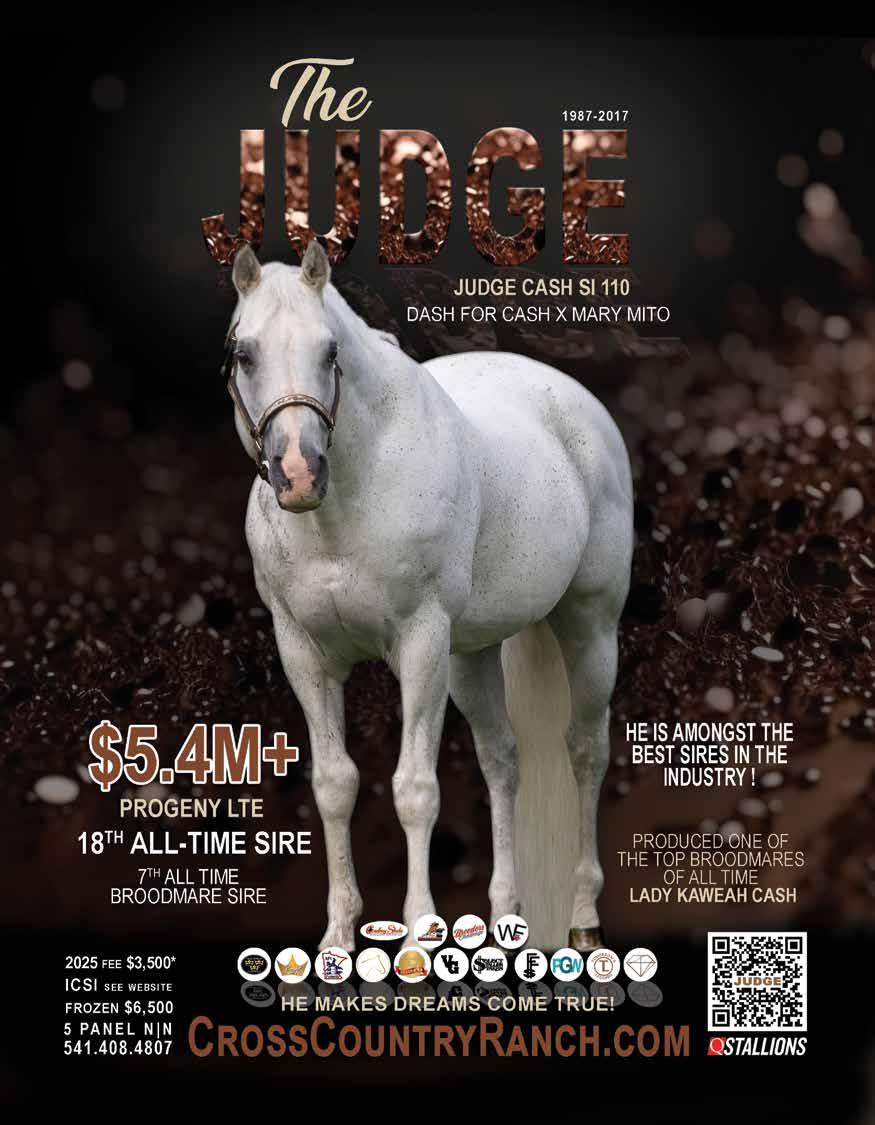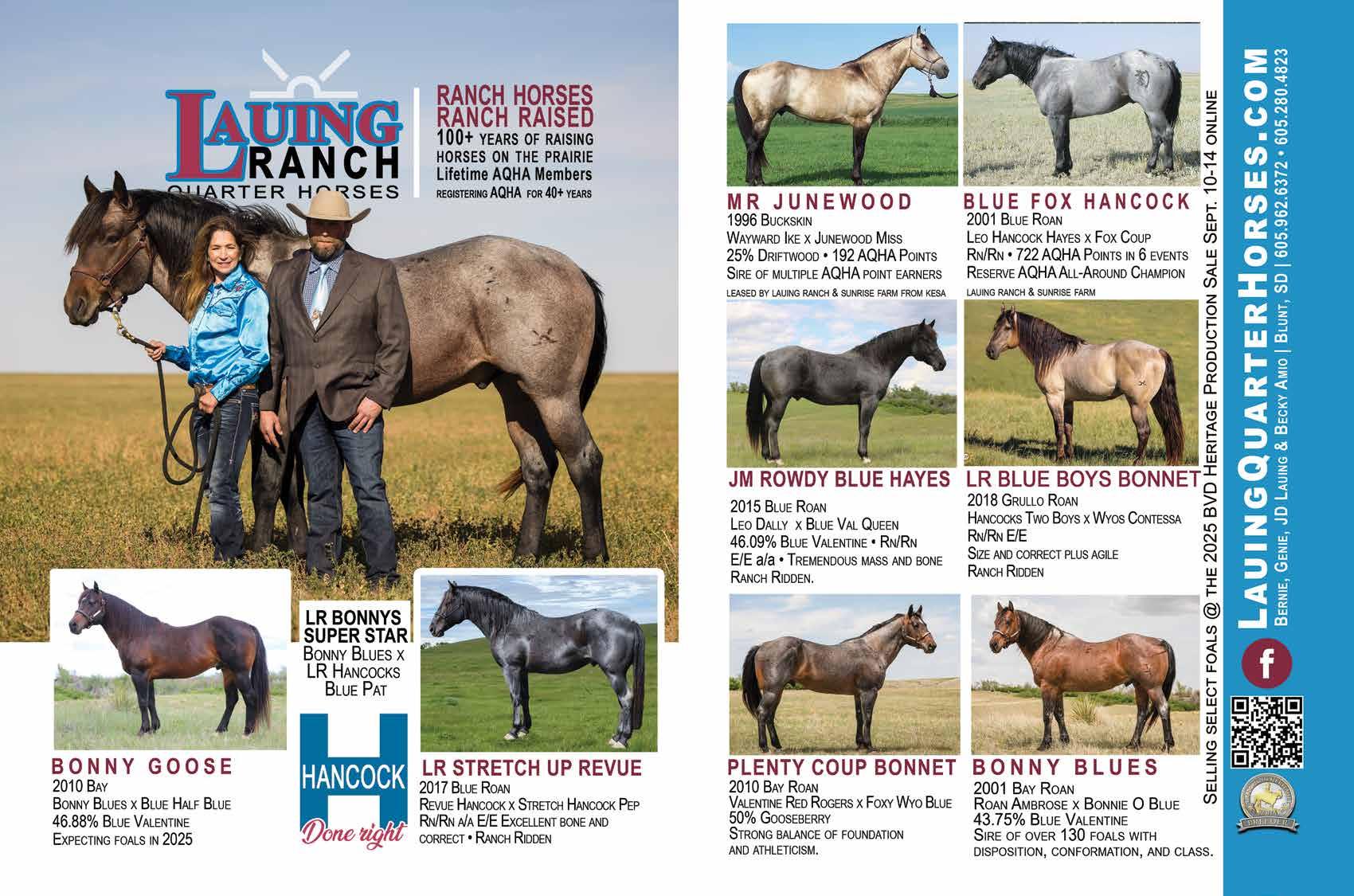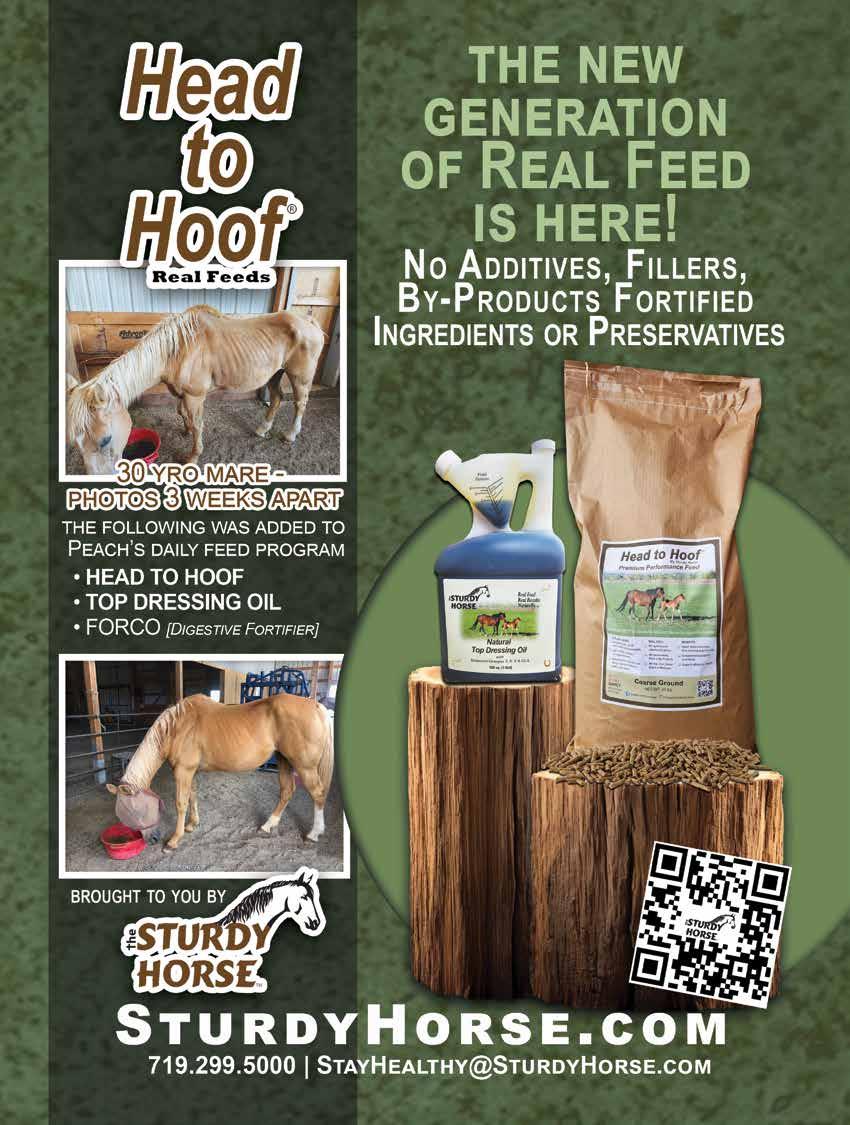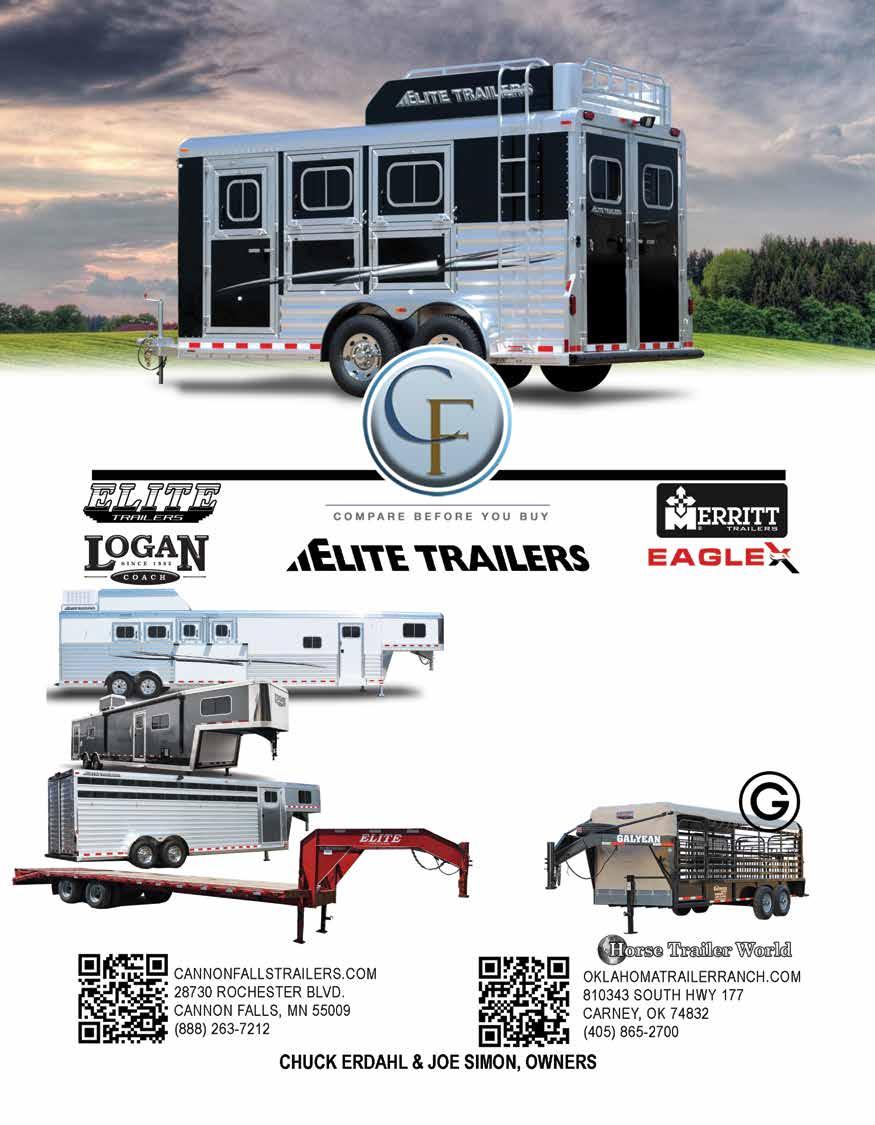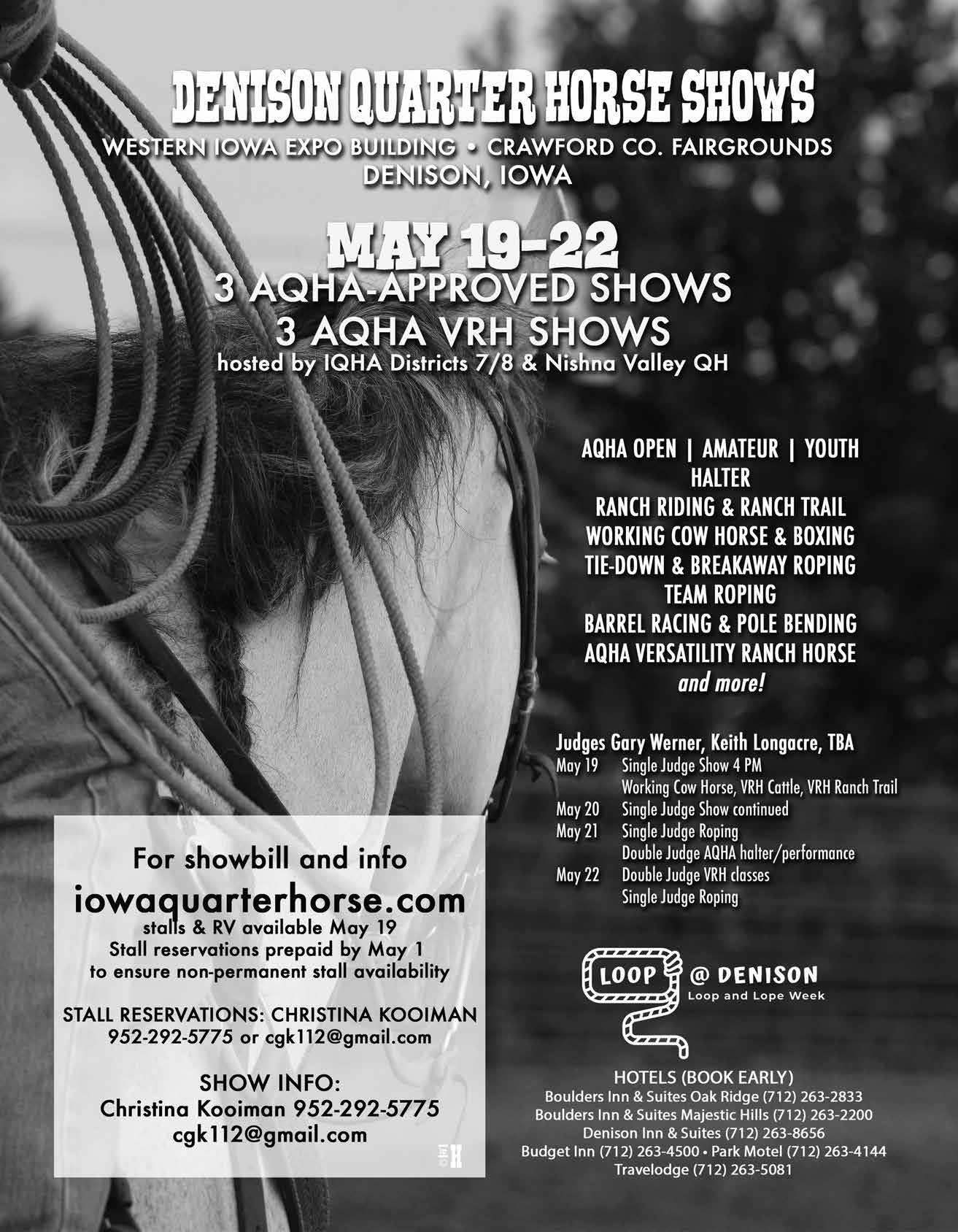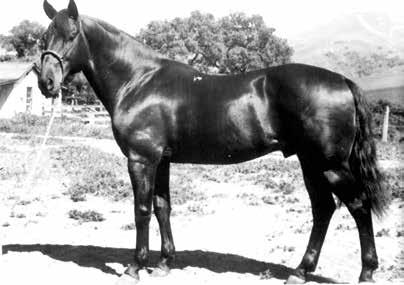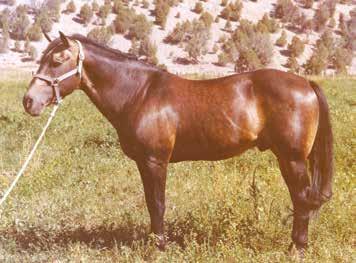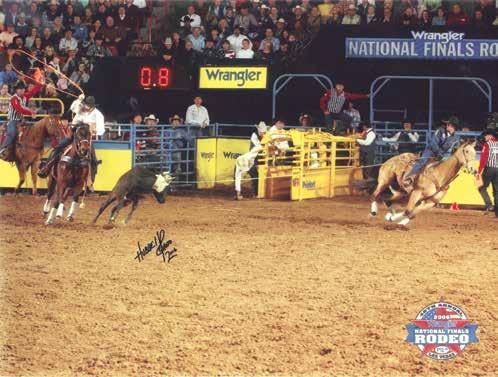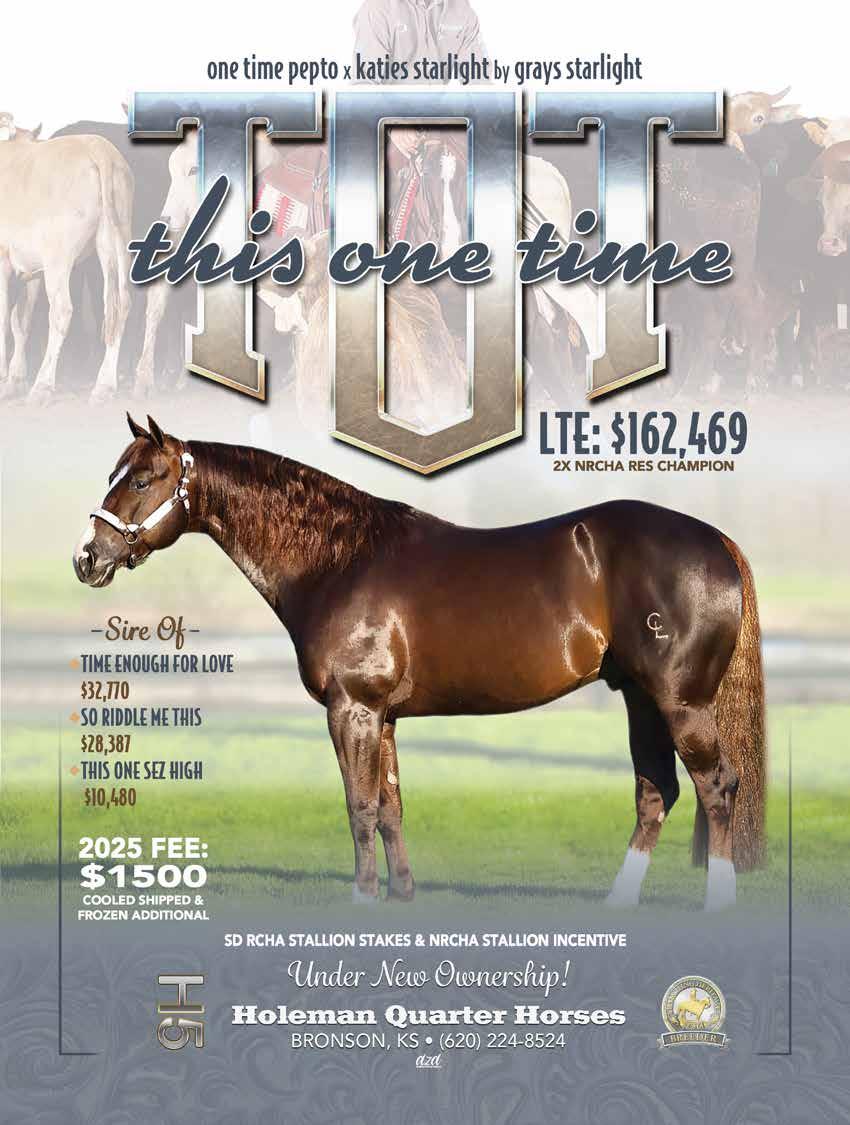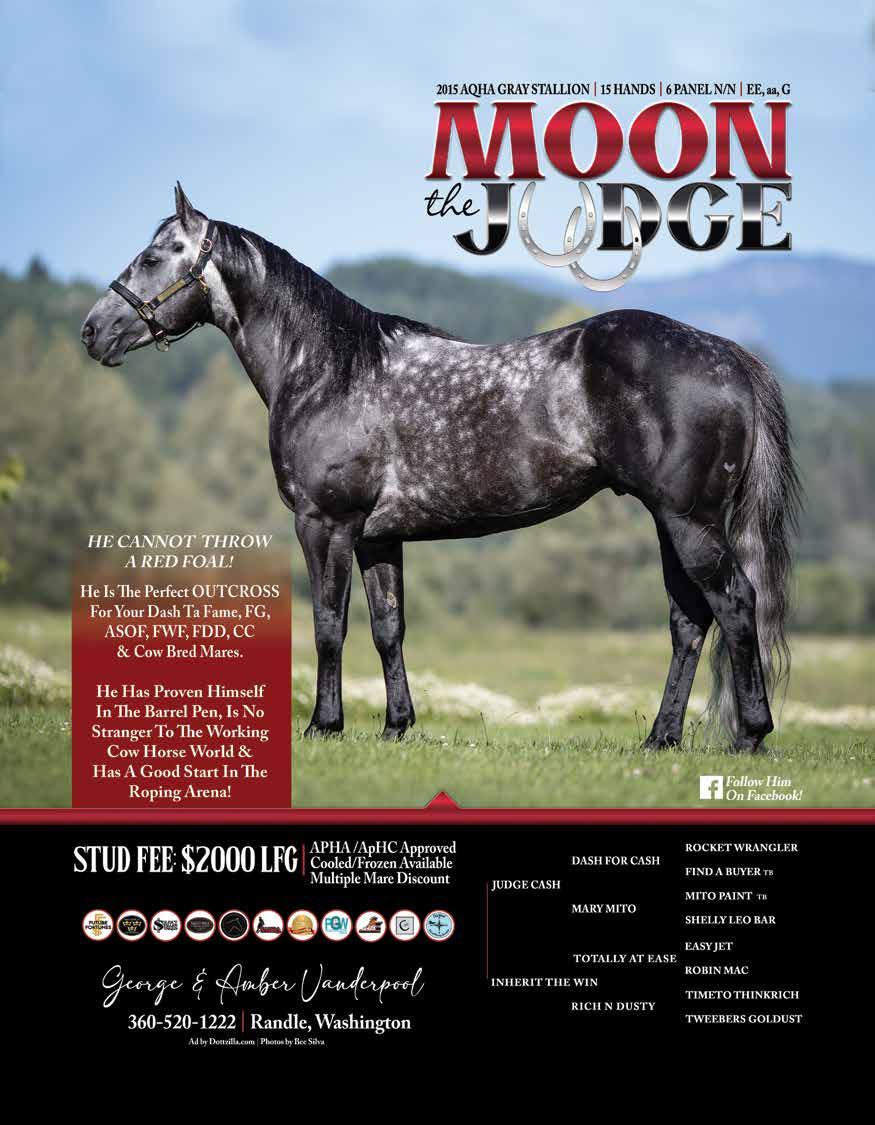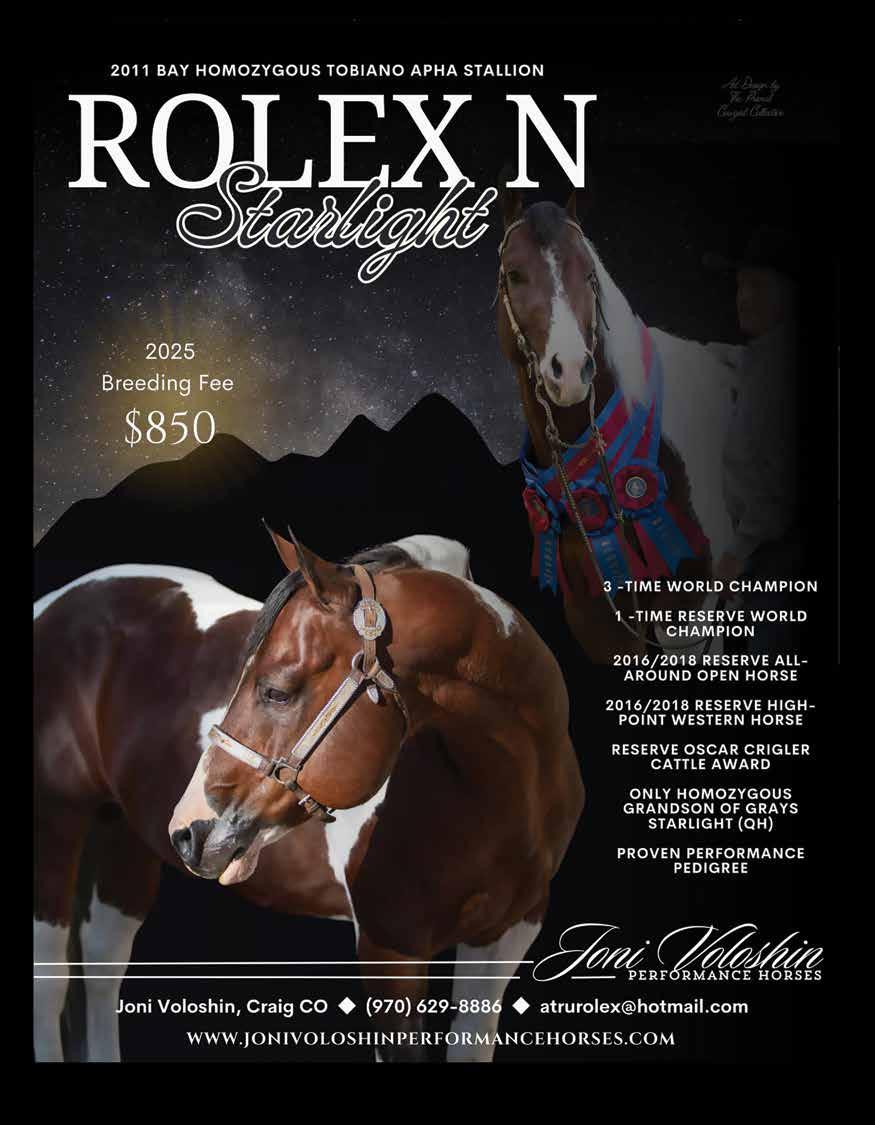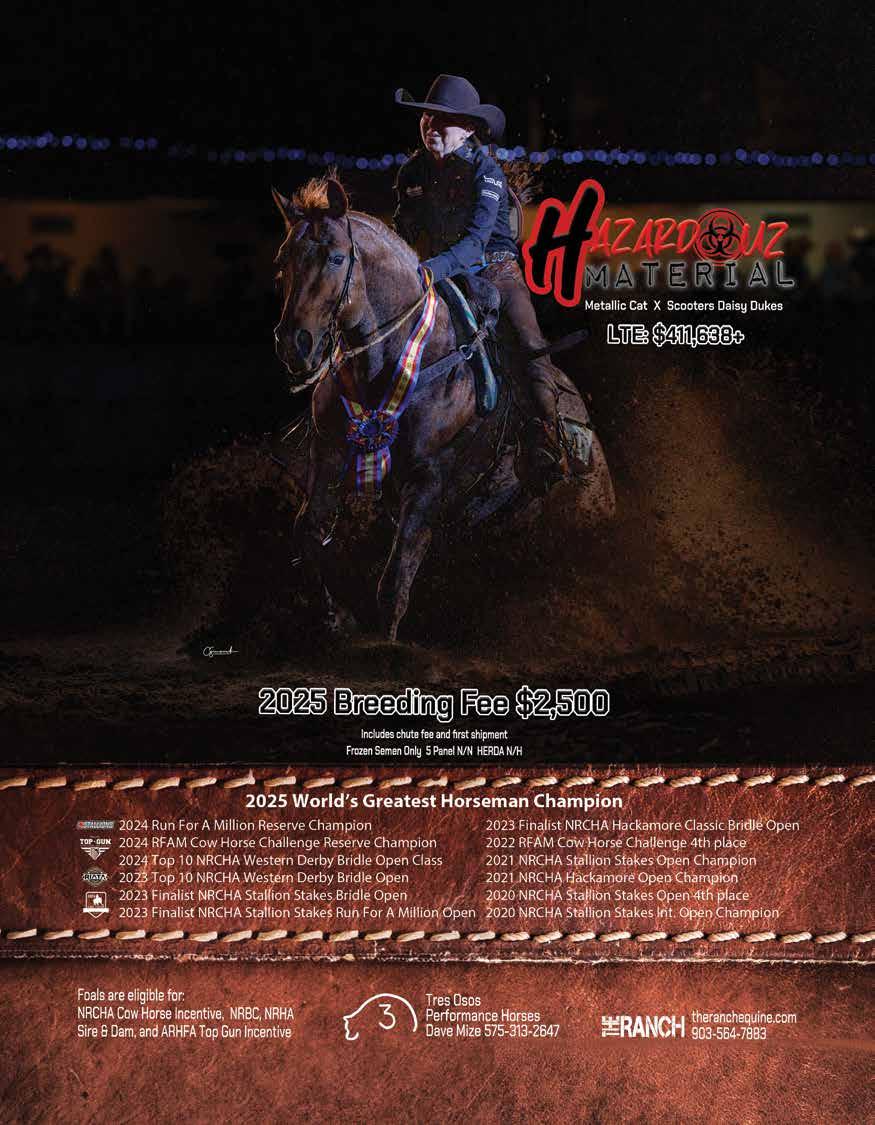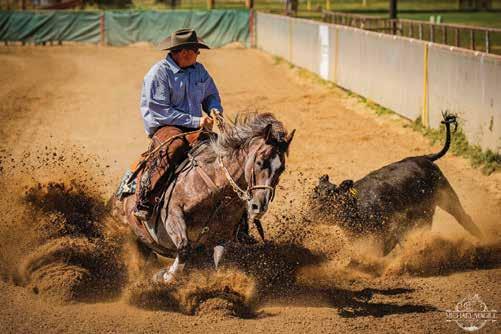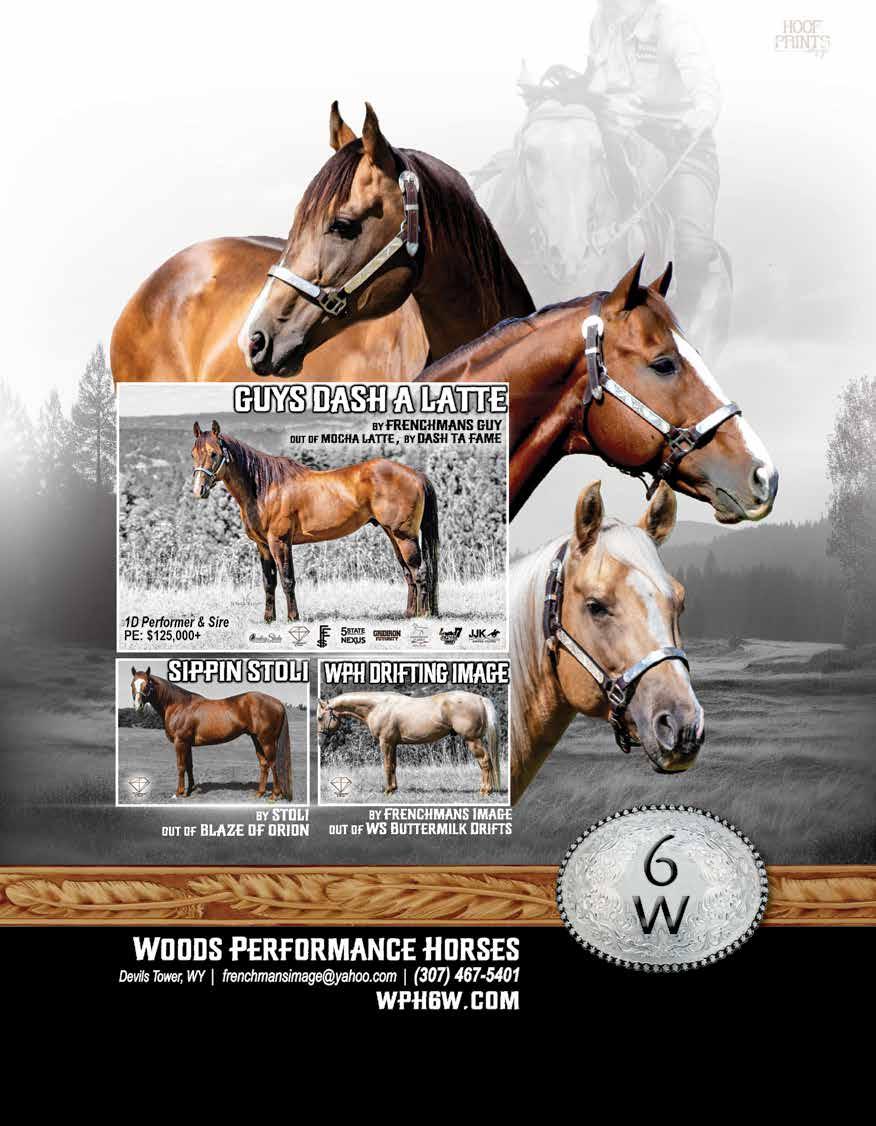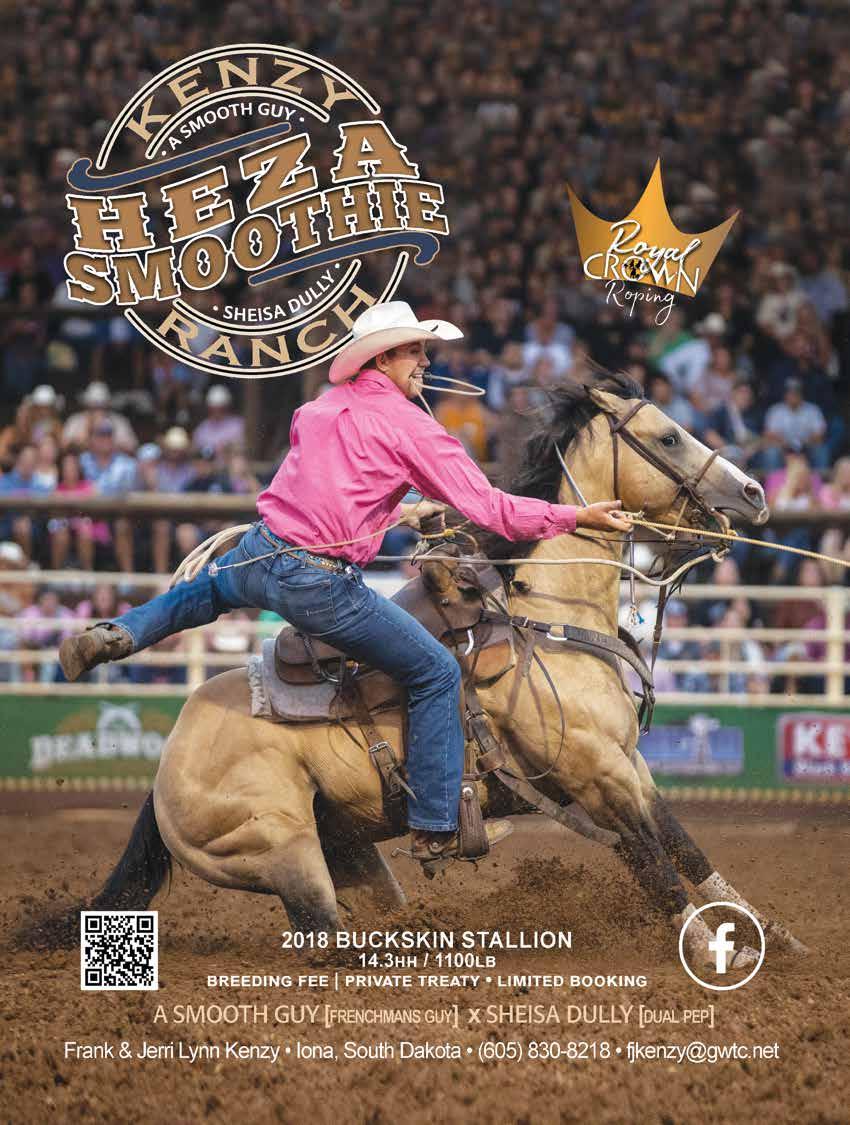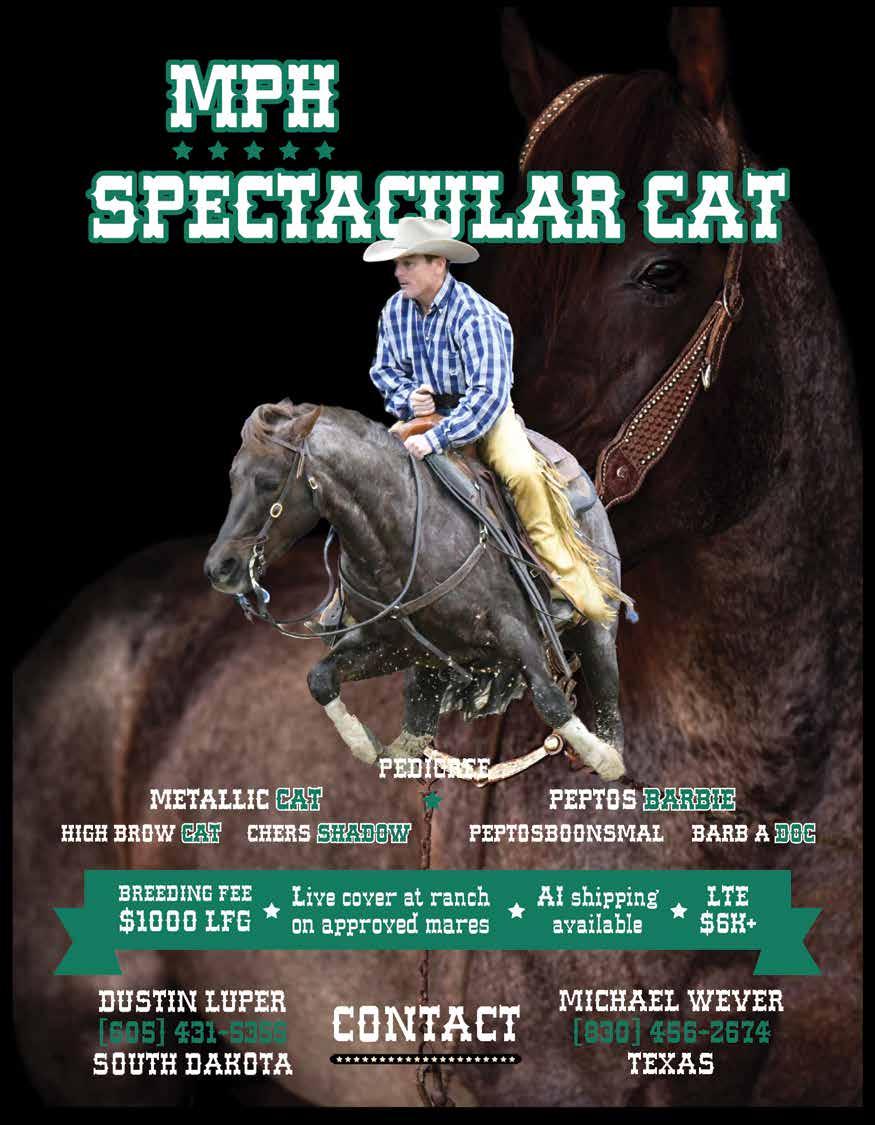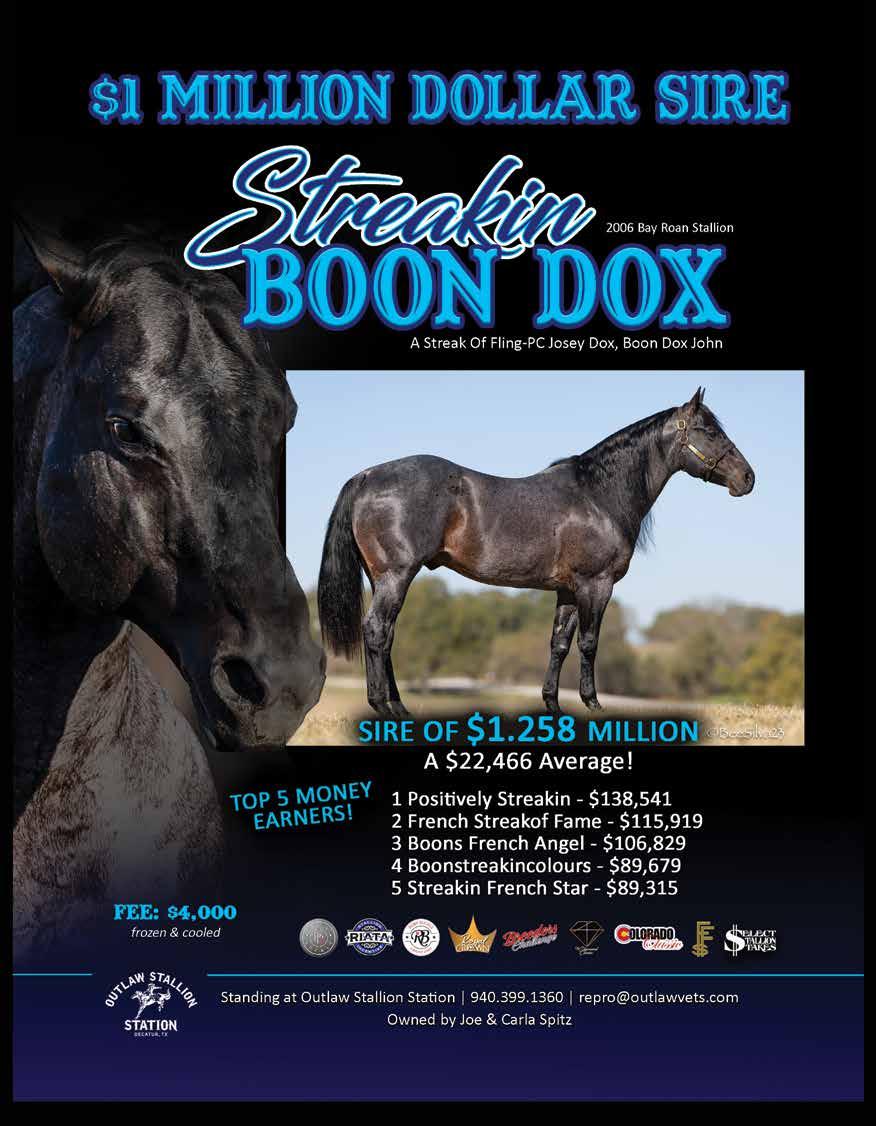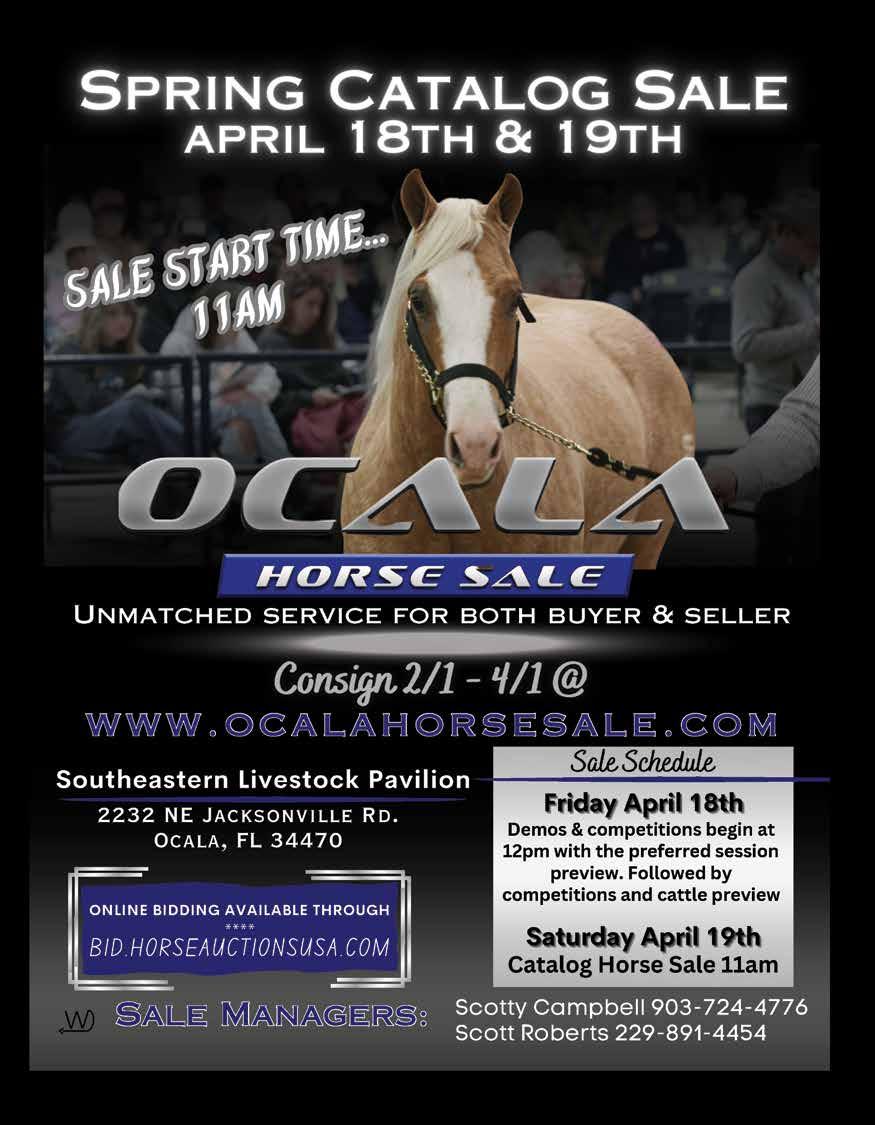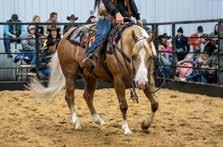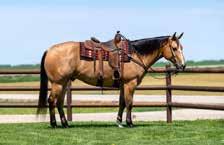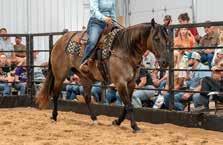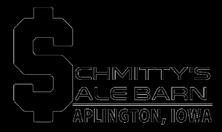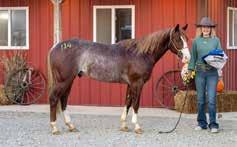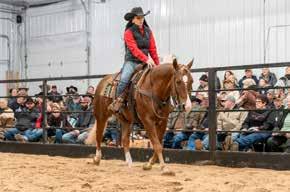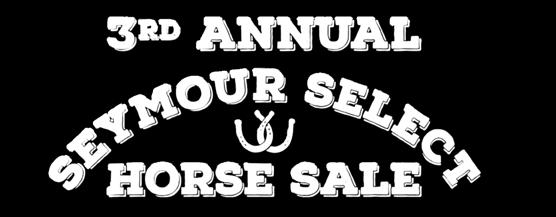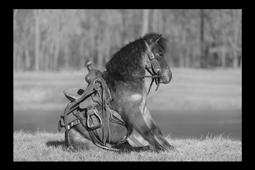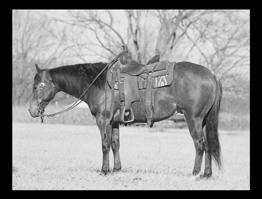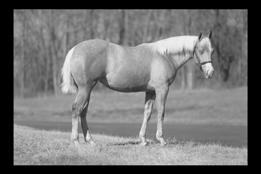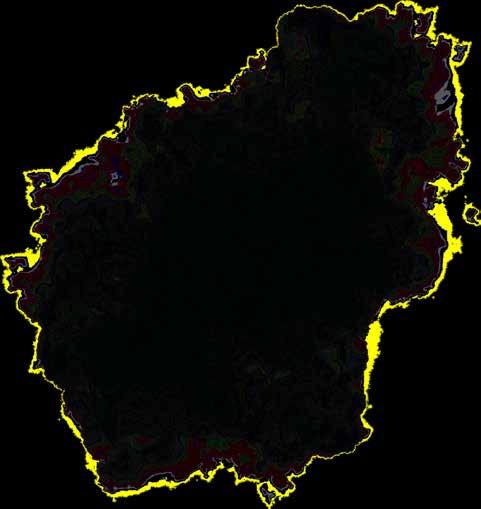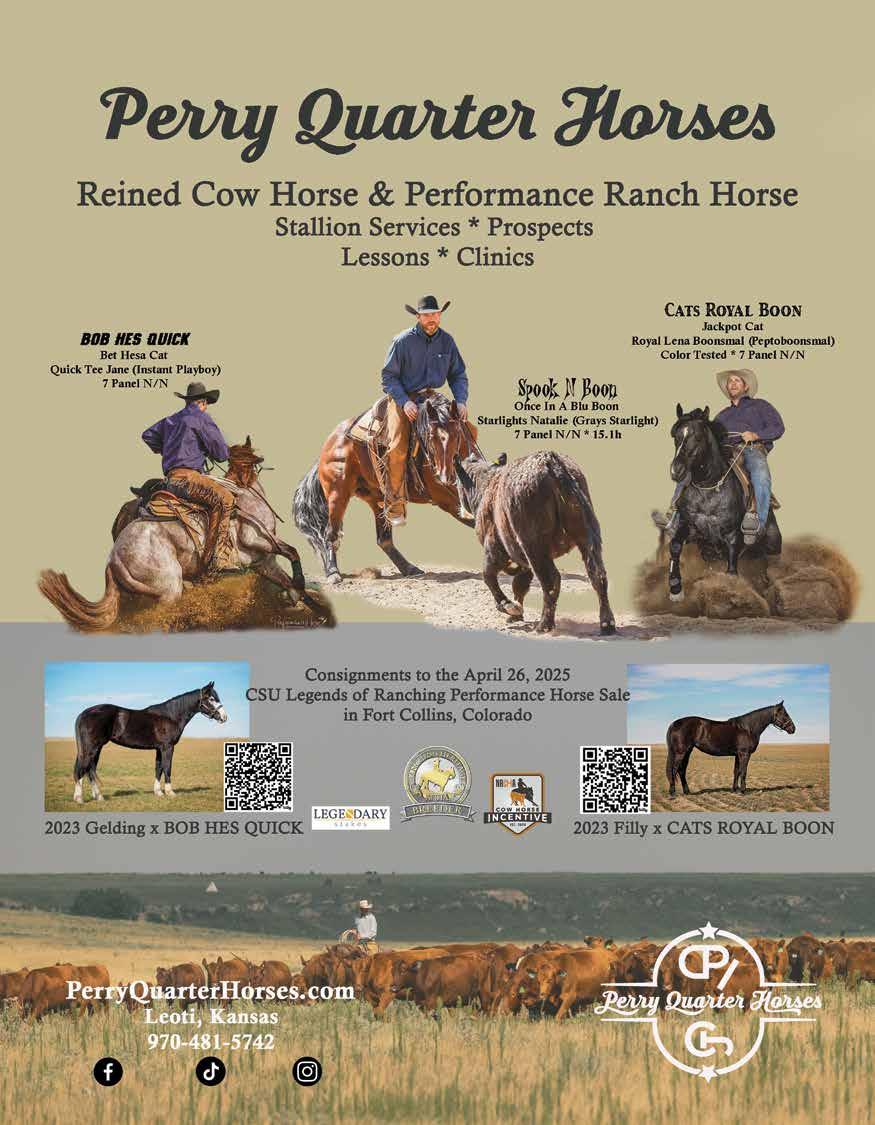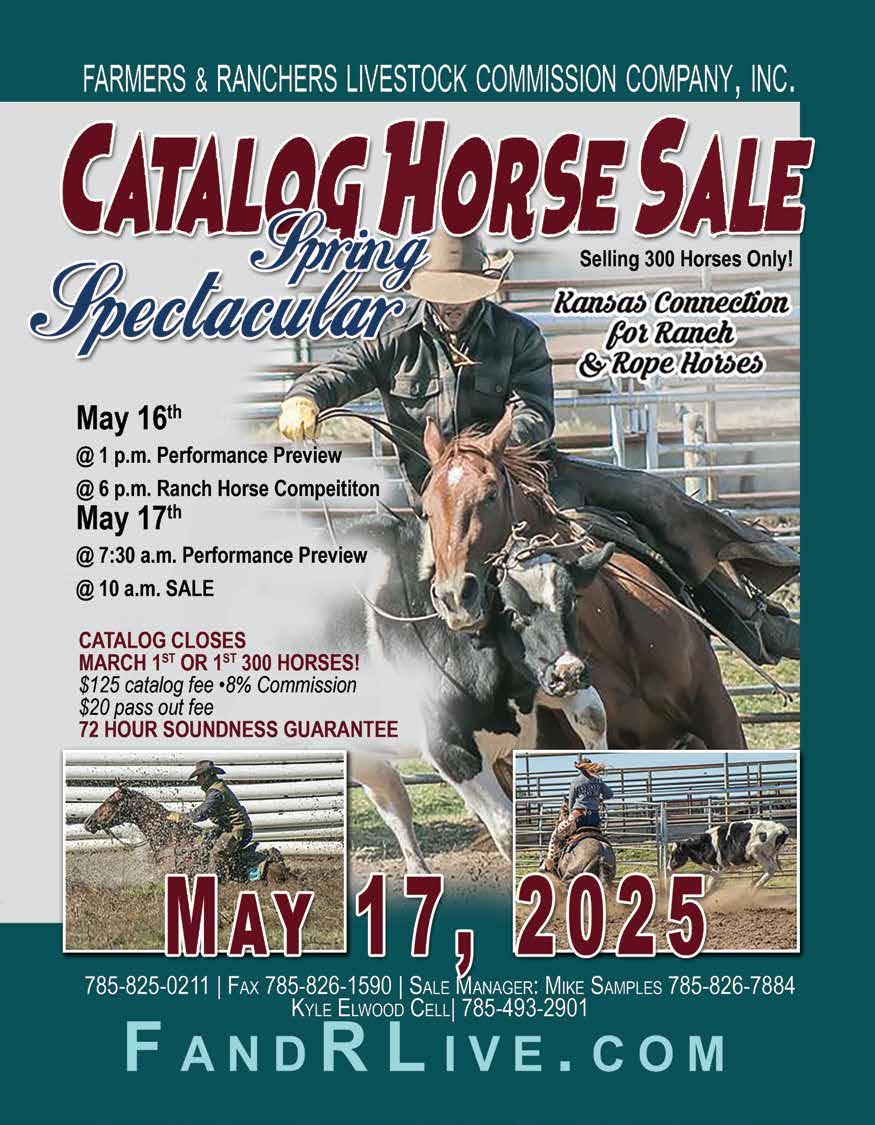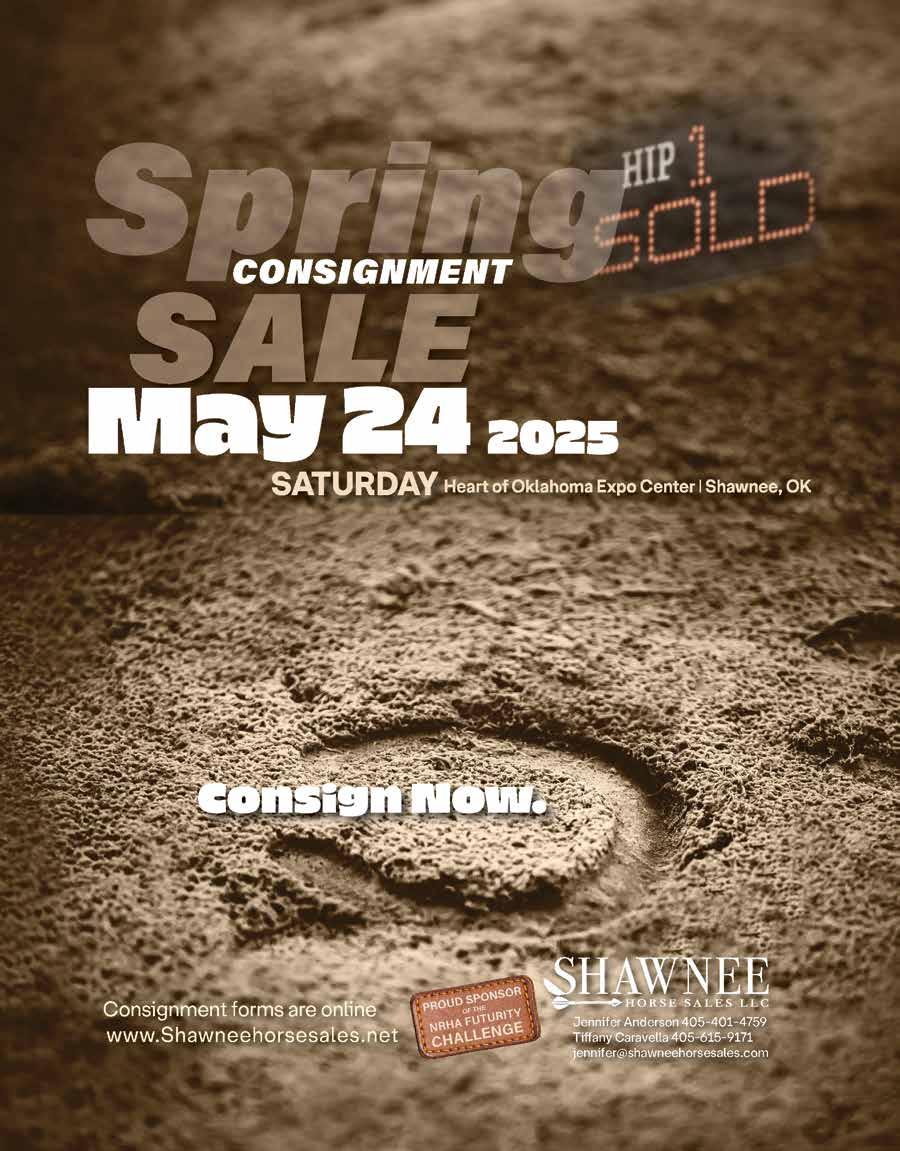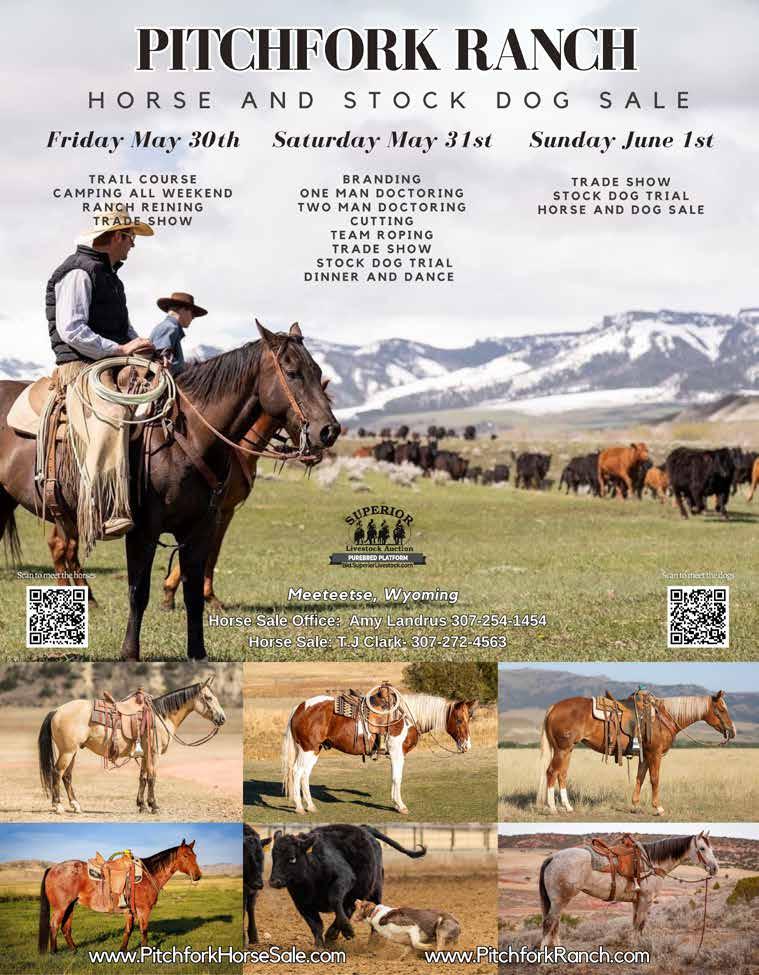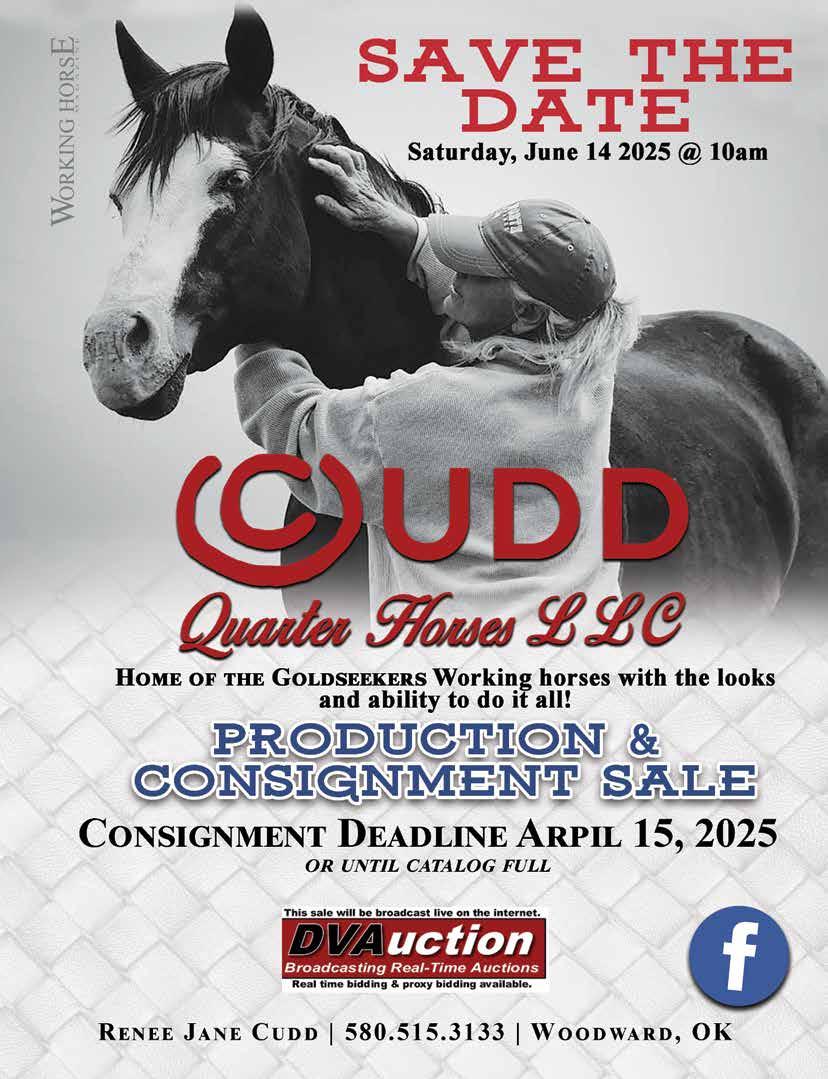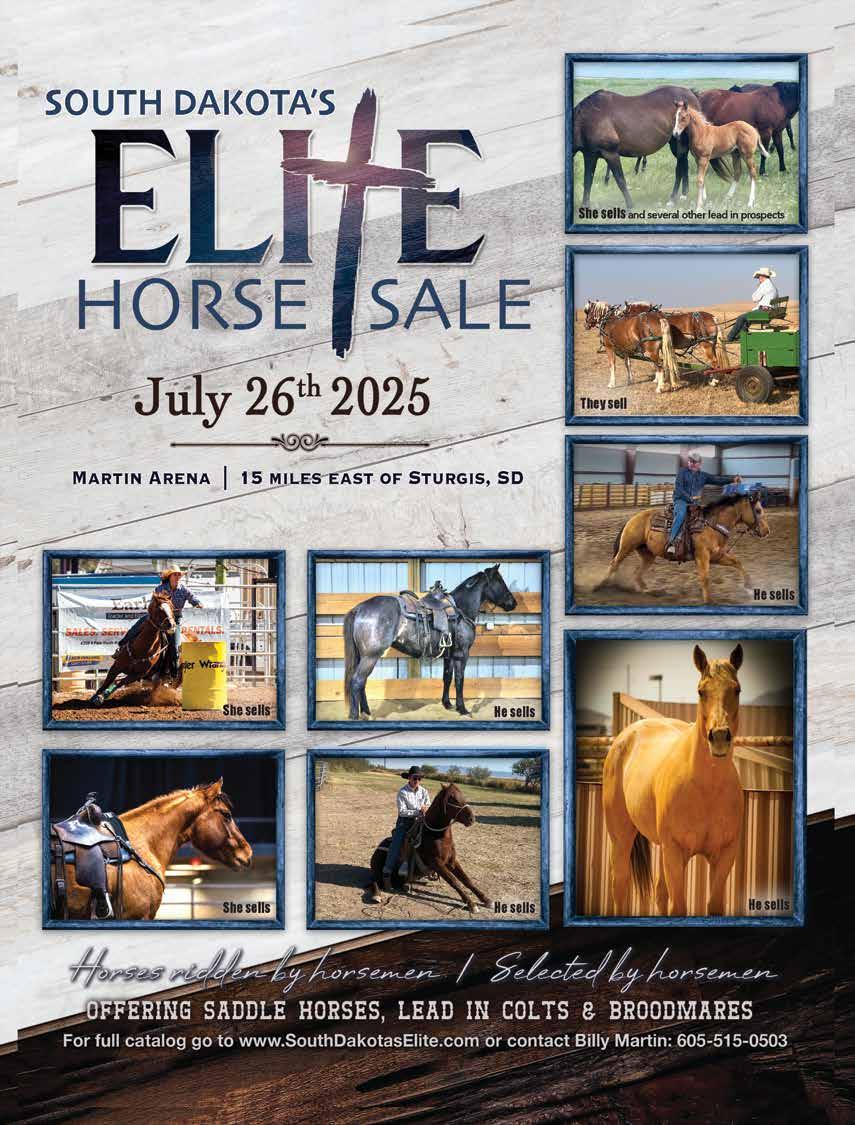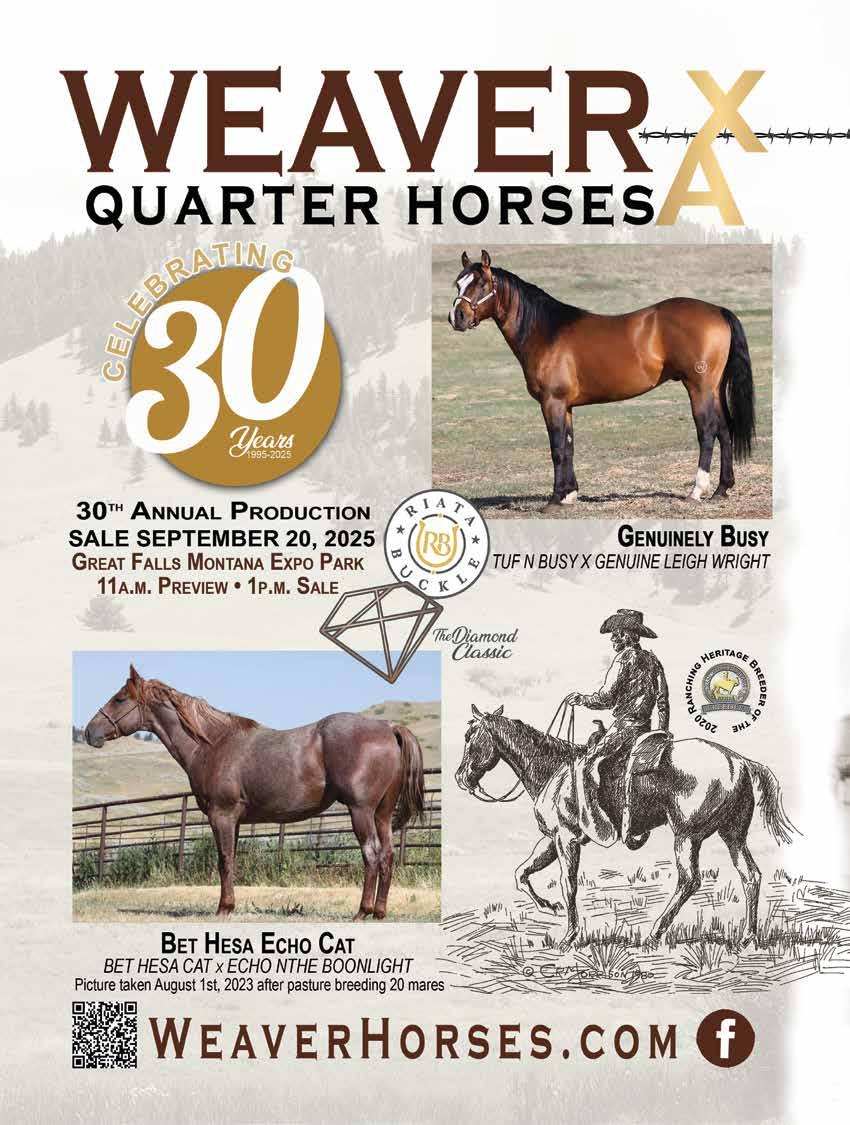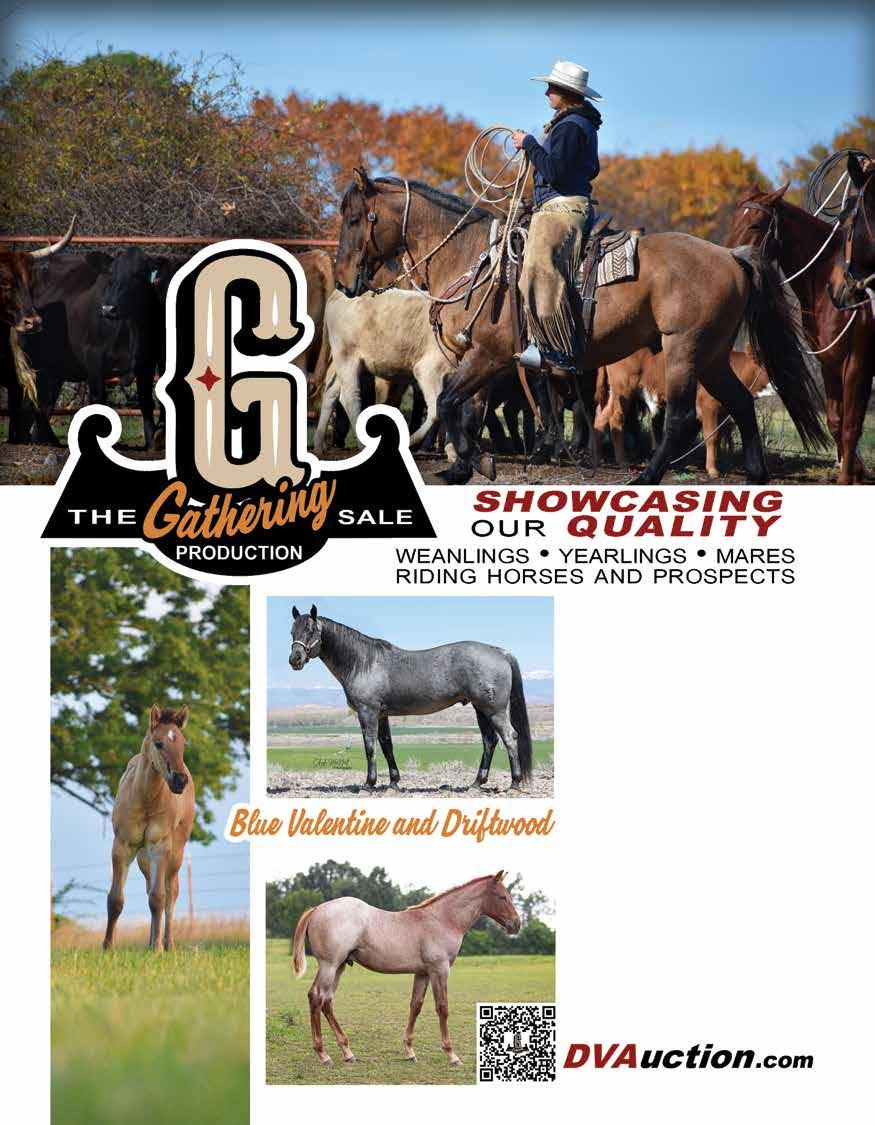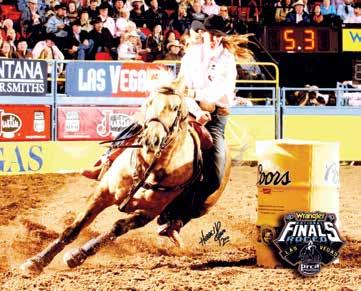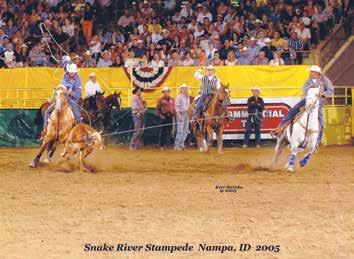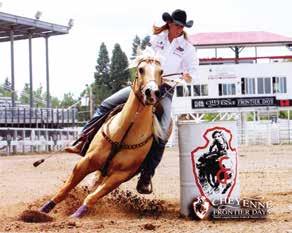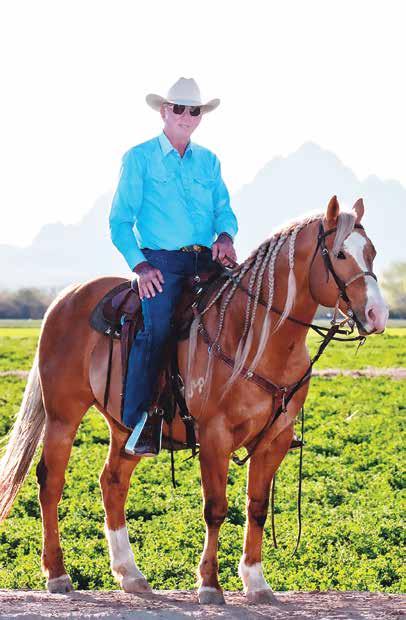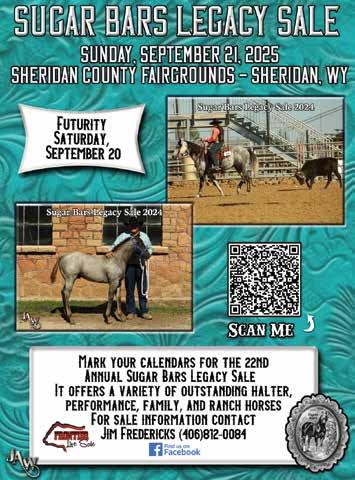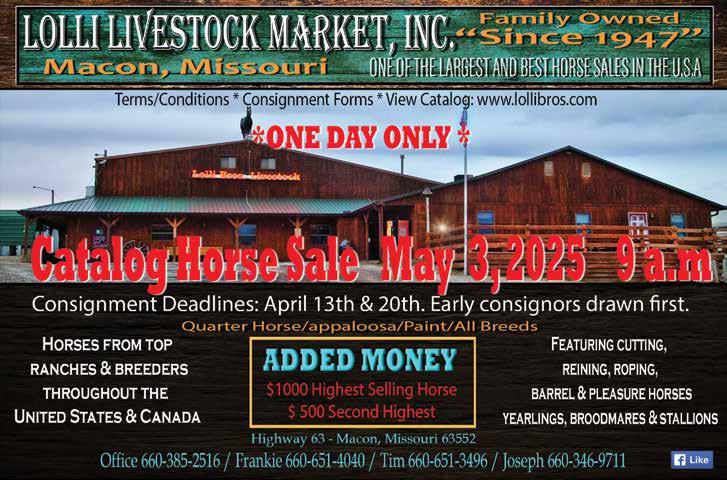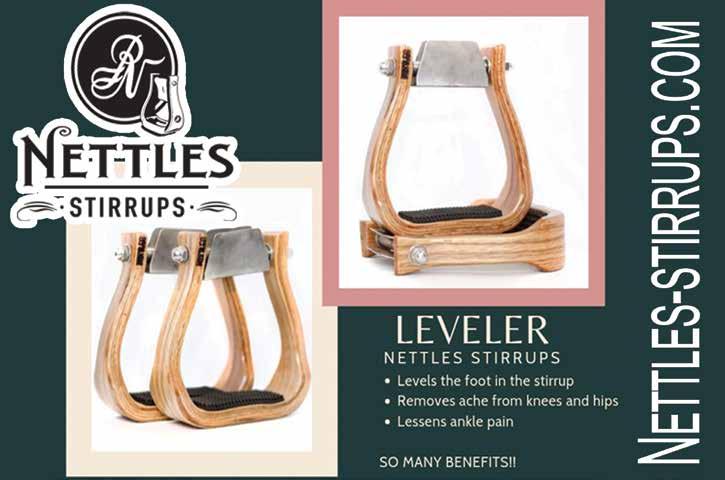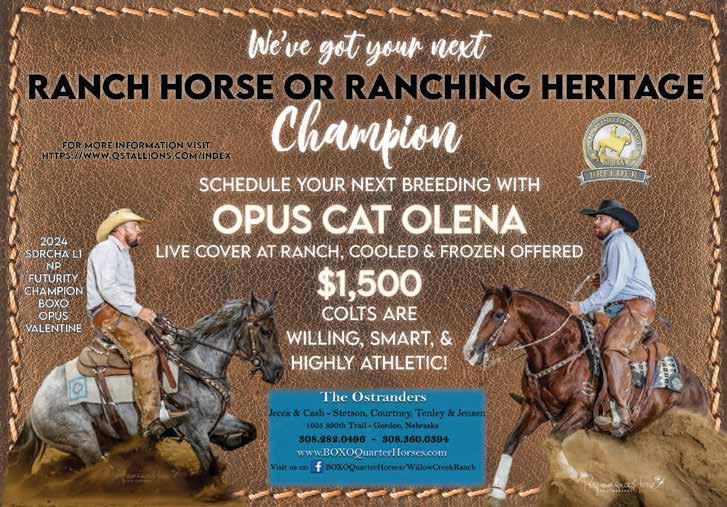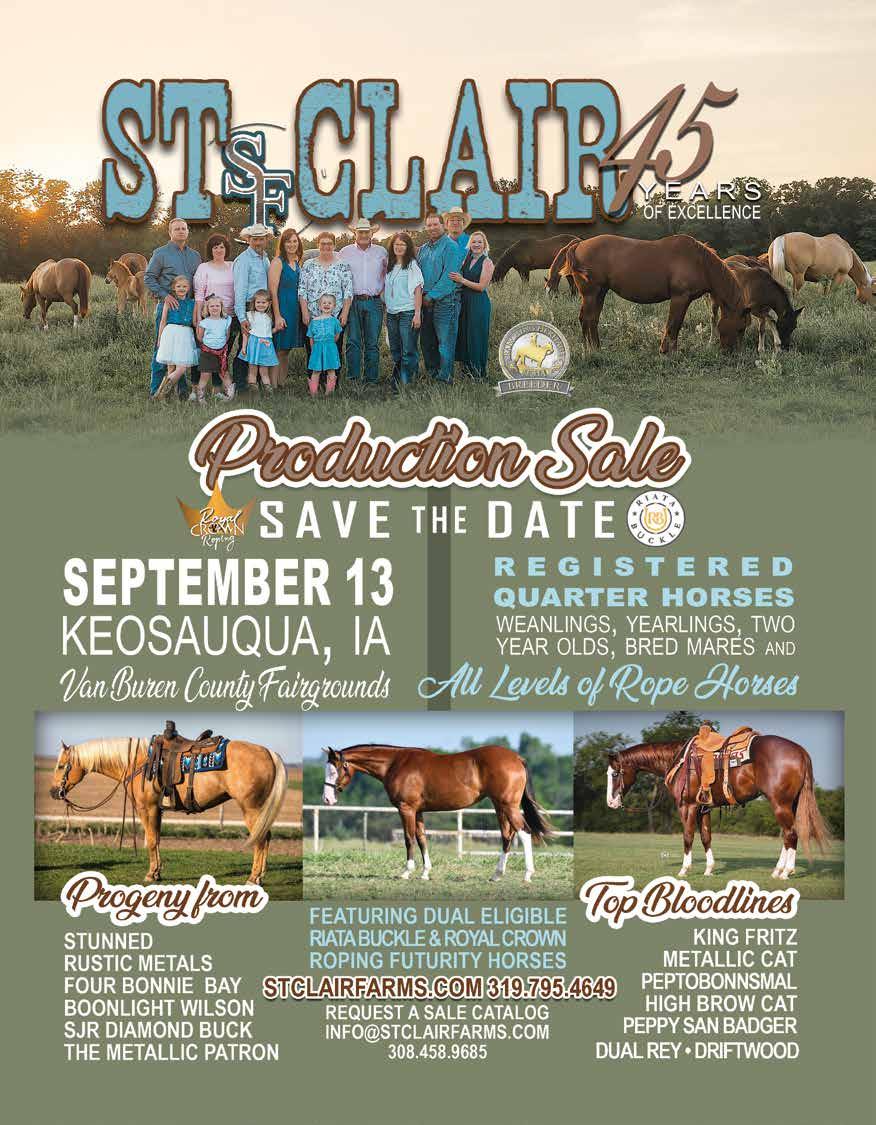WORKING LINESREMEMBERING MEL POTTER
By Larry Thornton
The horse industry lost a dear friend and horseman with the passing of Mel Potter on February 22, 2025. He began his journey to become a horseman as a boy fascinated with rodeo and roping. As Mel went through life, he lived horses. He became a successful roper, a rodeo producer, and a livestock contractor. Mel’s success in rodeo has garnered many honors, including induction into the National Cowboy and Western Heritage Museum Rodeo Hall of Fame. To round out his success in rodeo, he became a breeder of fine quarter horses, which solidified his contribution to modern rodeo. Let’s look at the commitment of Mel as a breeder as an example of his dedication and contribution to the quarter horse and rodeo.
The story of Mel Potter starts in 1944 when, as a young boy, his family moved to Arizona from Wisconsin to help him control his asthma. The move to Arizona opened a door for Mel to become a lifelong rodeo-roping enthusiast and participant. Mel didn’t know anything about roping, but he fell in love with it. By the time he was in college he was a four-time All-Around Cowboy as a member of the University of Arizona Rodeo Team. He was a PRCA National Finals Rodeo qualifier who won the fifth round of the first National Finals Rodeo. He was the winner of such major rodeos as Cheyenne, Denver, Calgary, Pendleton, Las Vegas, Tucson and Phoenix. He was a rodeo livestock contractor and has been a member of numerous boards related to rodeo and western heritage organizations such as the PRCA. He was not only inducted into the National Cowboy & Western Heritage Museum Rodeo Hall of Fame but also the first hall of fame inductee to be awarded the Ben Johnson Memorial Award for his dedicated service to rodeo. He earned these honors in 2005.
Mel tells us the story of how it all got started. “When I was young and started roping and got into rodeo, most of the horses in this country, Arizona and California, were Driftwood horses. A big percentage of the contestants were riding Driftwood bred horses. I realized they were good, and everybody was bragging on them. I kind of thought they were good because all these good guys trained them and rode them.”
He continued, “Everybody was bragging on how easy they were to train. I assumed it was the guys riding them that made them so good. Then I rode some of them. Dale Smith let me ride Poker Chip.” Poker Chip Peake was his registered name, and he was sired by Driftwood and out of Sage Hen by Waggoner.
He described Poker Chip this way, “That horse was so impressive, it was unreal it was like having a magic wand when you entered the rodeo. I guess it was almost like having money in the bank when you rode that horse. He was so awesome in
DRIFTWOOD FOUNDATION SIRE FOR MEL POTTER’S BREEDING PROGRAM
Photo Courtesy the AQHA Hall of Fame and Museum
every area that if you could rope at all, you could win money. I won quite little on him. I didn’t ride him all that much oh maybe six to ten rodeos, but I won or placed almost every time. So, I knew the Driftwood’s were outstanding horses.”
Mel related this about what put him over the top as a member of the Driftwood fan club, “What convinced me was the colt I got out of a little mare I roped on. I broke this mare when I didn’t know anything, and she didn’t know anything. She was 18 months old when I bought her, and I made a rope horse out of her. I didn’t know how to rope. I had seen rodeos, and I would go home and try to remember what they did. Looking back on it, it was naïve of me to think I could learn how to rope, but I did.”
He added, “This little mare was pretty decent considering her training. With me training her and, I didn’t know how to rope. Anyway, I bred her to a horse of Dale Smith’s named Speedywood, a son of Driftwood. Speedywood was a full brother to Driftwood Ike. There were four full brothers and sisters out of the mare Hancock Belle. The others were Maestro Eddi,e Schell won the world, Chilena, and Buckwood. They were all outstanding rodeo roping horses.”
He continued, “Anyway, I bred this mare to Speedywood, and I got this horse colt that I cut. I broke him when he was a long two-year-old. He was gentle and easy to break. Nice colt. Then, right after he turned three, I started roping on him. Break away calves and scoring. He was tracking cattle real good but I had never gotten off him.”
It was at this point that Mel related one problem in the training of this colt, “He wasn’t stopping like you needed a horse to stop back in those days. You needed a killing stop, or you got ate up by the size of cattle we were using in those days. He was stopping but it wasn’t real hard. So I went down to the arena with my chute help of my wife Wendy. I told her to put one of those team-tying steers in the chute.”
He continued, “I thought, well, I’m going to give this horse a heck jerk to see if I can get him to really pay attention to want to stop. So, I roped this team-tying steer that weighed about 650. This steer was bigger than we normally teamed today. I ran up
on that ole steer, and I roped him and pitched the slack in the air. When that steer hit him, he wasn’t expecting anything like that, and it almost jerked him down.”
“Well, I said put another one in, and I ran up on that steer and waved that slack on that, and that little son of a gun got in the ground with all four feet. He was braced up and was not going to take another jerking like he just had. He jerked that second steer straight up over backwards. I couldn’t believe it. That’s how fast he learned. That really impressed me. All this happened one evening in about an hour or hour and a half.”
Potter added this about the next phase in this colt training, “I had a lane that I brought my cattle back into, and so I trotted that horse down that lane and pitched that rope and got off, and he started to back up. He just started running back in that 14-foot lane and so I did it again and I’ll tell you when I stepped off him, I almost didn’t get the end of the rope because he just flew back. Talk about a horse learning fast.
“I told Wendy to put one of those calves in the lane I’m just going to rope one of these calves to see what happens. Man, I run straddle that calf and pitched that slack and it just ripped that calf down and he just came sledding to me. The calf didn’t even have a chance to get back on his feet. I helped him up and then flanked him and tied him.”
“I tied two more in that lane, the same thing every time. He was working better than the calf horse I was roping on, just roping those three calves. So, I decided to try it in the arena and out in the arena the same thing. He would rip them down and run backward.”
“So that was the same week of the Phoenix Rodeo, which at that time was one of the top five outdoor rodeos with the likes of Calgary, Salinas, Pendleton, and Cheyenne. But Wendy said
you should take him to Tucson to the horse show that was going on that same weekend. She said you ought to enter him in the junior roping at the quarter horse show. The way he is working, he might just win it.”
The problem was that Mel was planning to go to the rodeo in Phoenix. So, Wendy took Mel’s heading horse and calf horse to Phoenix and Mel took “Charlie” to Tucson. Mel would fly to Phoenix when he was finished in Tucson.
After a quick lesson in how to load into a trailer, Mel found himself at Tucson and his next obstacle, “Around home he stood around like an old dog, but when I unloaded him at the fair there was farris wheels, flags, more horses than he had ever seen before and his ole eyes were bugged out and acting like a completely different horse. I thought this is going to be the biggest wreck I’ve been in my life. Again, I realized how naive I was to take a green horse like this to a big show.”
“Then I realized I had never run him through a barrier. Luckily, they were having a halter class in the arena, so I got a friend to hold the barrier up a few times. Well, that barrier snapping was scaring him and pretty soon he acted like he didn’t want to go behind that barrier. So, I decided to wait for the barrier to pop before I took off.”
Mel interjected this about what he was up against, “Now this Tucson show was one of the five biggest horse shows in the country as well. Fort Worth, Denver, San Antonio, and Houston were the others in this top five. All the big trainers were there-- Matlock Rose, Lanham Riley, Amy Gamblin, and Jess Goodspeed.”
He concluded this part of the story this way, “When I nodded my head, the first thing that colt saw that he liked was that little ole calf running out of there. I mean he just knocked his tracks
GRAY CHIP DRIFTWOOD MILLER BOY b 1922 gr 1953 b 14.3 1932 THE COMER MARE sor 1912
DOUBLE DRIFT QUARTER HORSE SUGAR TIT KELLY 5 gr blk 1956 #0052102 gr 1942 LOUSE SCHUYLER b 1936 QUARTER HORSE ROSE WOOD DRIFTWOOD MILLER BOY b 1922 #0085080 b 1954 b 14.3 1932 THE COMER MARE sor 1912
DRIFTS CHIP QUARTER HORSE MISS HONDO HANK 1 blk 1979 #0066244 b 1942 NELLIE 21
QUARTER HORSE DIAMOND CHIP SILVER KING OLD SORREL ch 1915 #1495390 b 1948 b 1937 CLEGG MARE NO 3 b DIAMOND ISLE QUARTER HORSE SCAR FACE S BAILEY dun 1914 b ro 1959 #0013339 br 1935 MARE BY MIDNIGHT gr QUARTER HORSE DUSTY BABE DUSTY HANCOCK ROAN HANCOCK b ro 1935 #0098894 b ro 1946 bl ro 15.0 1940 TRIANGLE LADY 12 buck 1939 MP THRIFTWOOD QUARTER HORSE 803 BABE RED JOE OF ARIZONA ch 1932 buck 2000 #0016445 b 1939 DREAMY 1 b 1935
QUARTER HORSE DRIFTWOOD MILLER BOY HOBART sor 1918 #3991158 b 14.3 1932 b 1922 WYLIE b 1916
DRIFTWOOD IKE QUARTER HORSE THE COMER MARE BARLOW ch 1895 buck 1954 #0002833 sor 1912 KENTUCKY TB MARE
QUARTER HORSE HANCOCK BELLE BUCK 8 CHICARO b 16.3 1923 #0047645 buck 1944 YELLOW JACKET MARE dun
DRIFTING TULE QUARTER HORSE MISS HANCOCK 1 JOE HANCOCK br 15.3hh 1923 buck 1980 #0005593 WAGGONER MARE
QUARTER HORSE SPEEDYS STONE SPEEDY PEAKE DRIFTWOOD b 14.3 1932 #1676627 br 1961 br 1956 SHU CAT blk 1943
SPEEDYS TULE QUARTER HORSE JACKIES JOLEEN BUCKS BREEZE blk 1945 br 1970 #0187553 blk 1949 JACKIE GUINN blk 1940
QUARTER HORSE ALISOS GYPSY ALISO EASY KEEPER b 1945 #0757983 b 1960 b 1952 DELLA DELL b 1945
QUARTER HORSE MISS BEACH POET MEDDLE ch 1940 #0736724 blk 1946 MARE BY ROCK
out and I roped the calf, and he jerked him down. He slid him back to me, and I got the calf up and flanked him down. I won it, and that was the seventh calf I had roped on him, and that is how I became sold on Driftwood horses.”
The gelding that made Mel Potter a tried-and-true Driftwood believer was called “Charlie.” He was registered as Speedy’s Redwood. His sire Speedywood was a son of Driftwood, and he was out of the mare Hancock Belle by Buck by Chicaro. Red Ghara, the dam of Charlie, was registered with the National Quarter Horse Breeders Association. She was sired by Red Joe of Arizona by Joe Reed P-3. Red Ghara was out of Gharzia by Ghara. Charlie went on to be a good calf horse for Mel that was used for heading, heeling, and as a pickup horse for Mel’s Rodeo Company. He later added barrel racing to his resume when he carried Jo Lynn, Mel, and Wanda’s oldest daughter, to a successful barrel racing career.
The next part of our story comes about when Mel got a call from his good friend Chuck Sheppard, “Chuck Sheppard was a heck of cowboy, and he was a good friend of mine. His daughter married John Kieckhefer and Chuck and John ended up owning Driftwood Ike.”
Driftwood Ike was the full brother to Speedywood, who sired Charlie. He was bred by Catherine Peake.
mare.” The dam of Mr Top Moon was Ford Falcon, a daughter of Lady Thomas Wilson. Lady Thomas Wilson was the dam of All American Futurity winner Decketta.
He continued about this phase of the story, “All of these mares were sired by Driftwood Ike or bred to Driftwood Ike. Chuck says we will split the colts. So, I started taking the fillies, especially the Driftwood Ike fillies. I got a few daughters of Driftwood Ike, and I got a bunch of granddaughters of his. That gave me 8 to 12 nice mares that were closeup Driftwood Ike. The other side of the pedigree was great, too. A lot of Poquito Mos and Wayward Irving horses that Chuck had used.”
Courtesy Mel Potter
Driftwood Ike has proven to be a great representative of the Driftwood line as both a performer and a sire. Driftwood Ike had a successful show career that shows in the AQHA he was ROM in the performance arena and served as the AQHA Reserve High Point Steer Roping Horse in 1969. He earned 31 tie-down roping points and 23 heeling points in the AQHA. He is the sire of many of the great Driftwoods including Orphan Drift, Stanley Johnston’s great stallion and Prissy Cline, the dam of Sun Frost.
Photo Courtesy Author’s Files
Mel continued telling how he came to start his Driftwood broodmare band, “They had a drought going on, and Chuck wanted to know if I had a place where we could run 10 to 15 mares. He wanted to send those mares, and a stud named Mr Top Moon. He was sired by Top Moon and out a heck of a
“In the meantime, Bud Tillard in Douglas, Wyoming, a good friend of mine, and his family were in the cattle business, and he wanted to get some Driftwood blood. Bud had some nice mares, and he would get a different stud about every 3 or 4 years. So, I called Chuck to see if I could get a Driftwood stud from him.”
“I called Chuck and asked him if he had a Driftwood Ike stud he would sell. He said I’ve got three three-year-olds, and they were Lone Drifter, Ike’s Last, and the other one, I believe, was White Lightning Ike. They kept two, and they let me have Lone Drifter. I think I got him because he had been injured. They had put a cast on the injury, but it didn’t heel straight. So, I sent him up to Tillard’s to put on his mares. He stayed there for about two or three years.”
Lone Drifter was sired by Driftwood Ike, and he was out of Moore Yen by Yendis by Top Deck. The dam of Moore Yen was Katy Mas by Poquito Mas. Poquito Mas was sired by Joe Moore by Little Joe. Joe Moore was out of the great race mare Della Moore. The dam of Poquito Mas was Yokohama by Spokane. The dam of Katy Mas was Wayward Katy by Wayward Irving. Wayward Irving was sired by Scorcher (TB) and out of Fair Play by Barney Lucas. Fair Play was also the dam of Band Play, by Band Time.
Let’s take a closer look at the pedigree of Lone Drifter. His sire Driftwood Ike was out of Hancock Belle by Buck. This Buck is reported to be a son of the thoroughbred Chicaro. The dam of Lone Drifter is Moore Yen. She was a granddaughter of Top Deck.
DOUBLE DRIFT THE PATERNAL GRANDSIRE OF MP THRIFTWOOD
DRIFTWOOD IKE
Photo
The broodmare sire of Top Deck was the famous thoroughbred Chicaro. The dam of Yendis was Sue Bob by Flying Bob by Chicaro. The dam of Katy Mas was Wayward Katy, who was out of Broken Foot by Chicaro Bill by Chicaro. This gives Lone Drifter a breeding pattern of 4 X 5 X 5 X 6 to Chicaro.
Katy Mas was sired by Poquito Mas by Joe Moore by Little Joe. Then we see that Chicaro Bill was the sire of Broken Foot, the second dam of Katy Mas. The broodmare sire of Chicaro Bill was Little Joe. This gives Katy Mas a breeding pattern of 3 X 4 to Little Joe.
PC Lonewood Ike (Frisco) is a 1998 gelding sired by Lone Drifter. This gelding gives us an example of the siring ability of Lone Drifter. This horse was a product of the Potter lease of Lone Drifter to the Cowan Ranch in the late 1990s. Colter Todd and Frisco have won such contests as Cheyenne and Pendleton, as well as the USTRC Open. This gelding also helped Tee Woolman win the heading at Pendleton in 2005. This good gelding has won in excess of $300,000 in the roping arena.
Cranberry Jane was a daughter of War Deck and out of Myrna’s Ike by Driftwood Ike. War Deck was a son of Top Deck. The interesting part of this is the Top Deck breeding Mel has used in his breeding program. Lone Drifter was out of Moore Yen by Yendis by Top Deck. The stallion that came with the Chuck Sheppard horses was Mr Top Moon by Top Moon by Moon Deck by Top Deck.
The next step in our story has to do with Mel’s busy schedule. He was not only a roper, but the family had its Cranberry business to run, an Arizona ranch to run and a rodeo company to manage. This didn’t leave time for Mel to focus on his horse breeding program and this led to his leasing his Driftwood mares to Pat Cowan of South Dakota and then to Haythorn Land and Cattle Company of Nebraska. They also leased Lone Drifter during this time.
Then Mel realized that his good Driftwood bred mares were getting some age on them. So, he brought them home and started his Driftwood linebreeding program. One of the Driftwood mares that Mel singled out was Cranberry Jane.
During her years with the Haythorn Ranch, Cranberry Jane produced Figure Four 226 and Figure Four 526. Both of these horses were named the Top Horse in the Working Ranch Cowboy Association. Figure Four 226 by Happy’s Warrior did it in 1999, and Figure Four 526 by Poco Bueno Image did it in 2005. Since her return to Arizona, Cranberry Jane has produced horses like Tyrell, whose registered name is MP Woody Mango. Tyrell hit the road with Tee Woolman in 2007, starting what appeared to be the road to a championship. Woolman found Tyrell on a visit to the Potter Ranch, and he asked Mel if he could take him on the road. Woolman and Cory Petska took Tyrell and his full sister Craisin (MP Cranwood) to New Mexico winning the USTRC at Albuquerque. They went on winning or placing at places like Oakdale, Red Bluff, and Corpus Christi. Mel estimated that they could have easily won $15,000 during this road trip. But Tyrell wasn’t able to finish the year as a severe leg injury cost him his life and brought to an end what appeared to be a very promising rodeo career.
But the pedigree of Tyrell and Craisin brings together the blood of Driftwood and Top Deck from both sides of the pedigree. He was sired by Lone Drifter. Lone Drifter being sired
WINSTON [MP tHriFtWooD] @ tHe nFr WitH CORY PETSKA
Photo Courtesy Mel Potter
FRISCO [Pc loneWooD ike] anD COLTER @ tHe nFr
Photo Courtesy Mel Potter
by Driftwood Ike by Driftwood. Lone Drifter was out of Moore Yen by Yendis by Top Deck. The female side of this pedigree shows that Cranberry Jane was sired by War Deck by Top Deck. The dam of Cranberry Jane was Myrna’s Ike by Driftwood Ike by Driftwood. This is a linebreeding cross of Driftwood on Top Deck and then Top Deck on Driftwood.
Mel had the nucleus of a good broodmare band through his Driftwood Ike daughters and granddaughters. But he didn’t stop there as far as he continued to develop his broodmare band by buying other mares that represent the Driftwood bloodline. This included a number of daughters of Red Rim Rock. Red Rim Rock was a grandson of Drifting Sage, a full brother to the great Poker Chip.
Red Rim Rock is the sire of a mare named Fancy, whose registered name is MP Speed Rock. Tee Woolman showed the 2000 red roan roping mare in the 2010 NFR. Fancy introduces us to another mare line that Mel has used in his Driftwood breeding program. The dam of MP Speed Rock is PC Speedy Sunzalez, a mare by Sun Frost and out of the Potter Ranch owned mare Speedy’s Tule.
We will let Mel tell us how Speedy’s Tule comes into the picture, “Reg Camarillo had a mare that was a Driftwood bred mare. She went to Speedy Peake and the other side went back to Easy Keeper. I asked Chuck if I could send her up there to breed to Driftwood Ike.”
sired by Waggoner, who was sired by Midnight by Badger by Peter McCue. The dam of Waggoner was a mare by Yellow Wolf by Old Joe Bailey. The dam of Smokey McCue was a mare by Harmon Baker by Peter McCue.
When Mel bred Speedy’s Tule to Driftwood Ike, he got a mare named Drifting Tule. Drifting Tule would play a key role in the Mel Potter Driftwood program as the dam of MP Thriftwood also known as Winston.
MP Thriftwood would have a very short but remarkably successful rodeo career with Cory Petska in the saddle. They started in October of 2005 with a first in the USTRC in Waco, Texas. They followed that up with a third in the finals of the USTRC at Oklahoma City in October. They then went to the Dallas Tour Finals in November, winning $12,000. The big win for this team came as the winners of the average at the NFR in December plus the Reserve World Championship in heeling for 2005. They won $87,000 in the NFR that year. The October to December show record earned $110,000. MP Thriftwood basically retired to the breeding farm after this short rodeo career, although he was used around the ranch to help out.
The sire of Winston is Drifts Chip, who was sired by Double Drift. Double Drift was sired by Gray Chip by Driftwood. The dam of Gray Chip is Sugar Tit by Kelly.
Speedy’s Tule was sired by Speedys Stone by Speedy Peake. Speedy Peake was sired by Driftwood and out of Shu Cat by King P-234. The dam of Speedy’s Tule was Alisos Gypsy by Aliso. Aliso was sired by Easy Keeper by Driftwood.
The dam of Easy Keeper was a mare named Smokey McCue. Smokey McCue was at least a ¾ sister to Sage Hen, the dam of Poker Chip Peake. Thus, Easy Keeper and Poker Chip Peake are at least 7/8 brothers being sired by Driftwood and out of a Waggoner/Harmon Baker bred mares. Smokey McCue was
The dam of Double Drift was Rose Wood by Driftwood. Her dam was Miss Hondo by Hank I. When we include his dam’s pedigree this gives Winston a breeding pattern of 4 X 4 X 3 X 5 X 6 to Driftwood. Our look at Winston has allowed us to bring the Driftwood breeding program into focus. This stallion certainly represents Mel’s dedication to the Driftwood horses. Driftwood also plays a role in our second look at Mel’s breeding program, and the role barrel racing plays in the program in the Mares With More.
WINSTON [MP tHriFtWooD]anD Mel
Photo Courtesy Mel Potter
*Eyem Fames Loretta
[Fames French Ryan x What An Eye Opener ] and Kricket Gintner winning Reserve Champion in both the BTuff Barrel Race and Minnesota Breeders Futurity!
*CC, a 2024 filly by Fames French Ryan and out of Firewater Strait Lace Owned by Hadley Quarberg
Horses tHat cut, coW Horse, rein, rancH anD roPe
By Ruth Nicolaus
with Tri-State Livestock News
The Jesperson family of Ekalaka, Montana, breeds all-around horses.
Cassidy and Tandi, along with their four children, breed and raise horses that can be used for ranching, roping, cutting, ranch rodeo and reined cow horse competitions.
The couple, high school sweethearts, grew up around horses. Instead of putting away money for a college fund for Cassidy, his parents, Ken and Becky Jesperson, let him choose some mares and breed them, and his granddads, James Barrett and Bill Jesperson, helped him in riding, training and showing horses in 4-H.
Tandi rode horses throughout her childhood, with her mom, Jitt Schneider, and granddad, Vernon Walter. Her dad, granddad and uncle competed in high school rodeo.
The Jespersons: [left to right] Fynn [kids’ guard dog], Cambri, Cai, Colt, Cashlyn, Tandi, and Cass. Dani Draine Photography
The couple married in 2008, moving to the Walter Ranch the next year as the fourth generation of each family to be part of the ranch operation.
It was two years after marrying that they got their start in raising and breeding. They had the mares Cass had raised, and along with a friend, they bought a horse, Smart Little Brady.
They had wanted to make a better ranch horse, something that would hold up in rocky, forest-service country, but also have the natural and easy ability to watch and chase a cow, and be trainable in a variety of roles.
Smart Little Brady “opened up a whole new world to us,” Tandi said, when they realized the stallion leaned more towards the cutting and cow horse industry.
But Smart Little Brady didn’t get to the size and shape they wanted, standing only 14.1 hands.
“We gelded him after a few years, because he didn’t get big and solid. He’s a gentle little bugger,” Tandie said, “but he just wasn’t what we were looking for in a stud.”
But Cassidy had realized how fun Brady was to ride, “how smart he was, and how cow work came so easy in the pasture. You didn’t have to teach it. It was just there.”
So cow horse and cutting horse were the aptitudes they wanted in their next stallion.
They purchased Shiney Red Cielo, who was more of what they were looking for. A 2008 son of Shining Spark, out of Peeparoo, a National Reined Cow Horse Association World Champion and money earner, the deep sorrel stands 15.1 hands. Spark, as they called him, had the size and versatility they wanted.
At 6’3” and 250 lbs., Cassidy wanted a horse that was not only big but built to handle rough ranch country.
“We knew, if we were going to do this,” Tandi said, “we needed to be able to say, his offspring will be able to cut, cow horse, rein, and do anything you want on the ranch. We didn’t want our horses bred for just one specific discipline, and we wanted them to have size.”
Cassidy showed Spark for a few years, but in 2016, the horse contracted a virus that nearly killed him. When he came home from the veterinary clinic, he was no longer sound; his show career was over.
For two years, they leased different studs, but “it wasn’t working for us,” Tandi said.
So, five years ago, at the National Cutting Horse Sale in Ft. Worth, they purchased their next stud, Reyzin the Boon 18, by Reyzin The Cash and out of Pinkolena Boon 2009.
Bred by James Eakin, who has bred several world champions, Boon has the versatility the Jespersons breed for.
“He fits the bill, pedigree-wise. In his line, you could cut, cow horse, rein, ranch and rope. We were looking for the whole package.”
Travis Young, Big Sky Performance Horses in Absarokee, Montana, started him and shows him. Boon is nearly at $30,000 in earnings in the NRCHA. He will show at the World Show in February in the 2-rein rig.
Standing 15.1 hands, “he’s not a tiny petite little cutting horse like Smart Little Brady. He’s a big soggy bugger. He has a bigger hip and he’s stockier built than Spark. He is everything we would want in a stud for ourselves and our program.”
They’re always on the lookout for a horse with the “wow” factor, and Boon had that.
“Walking up to a stall, you want people to notice” the horse, Tandi said.
Boon is eye-catching, she said, with his blaze face and white socks.
At the Black Hills Stock Show in Rapid City, “there’s not a soul that goes by (Boon’s stall) that doesn’t say, ‘gosh, that horse is pretty. I like that horse.’ That’s exactly what we were looking for.”
The Jespersons’ other stallion is PRF Purrfect Star, “Tornado,” by Smooth Talkin Style and out of PRF Purrfection. He’s smaller and more of a ranch horse. “We just love him,” Tandi said. “We call him our ranch stud.” Cassidy rides him for calving. Local folks have brought mares for Tornado to live cover and he also breeds older mares and mares hard to settle by AI.
“We are loving his colts. They have super fun, gentle personalities.”
It’s not easy showing reined cow horse and living in the Northern Plains, but the family makes it work. Cassidy and the kids show as members of the Colorado Reined Cow Horse Association, hitting between four and five shows a year.
of them with Cassidy and the kids. “We know what our mares are,” Tandi said.
“Most of them have won money in the cutting, cow horse, or roping, or have sires and dams in their pedigrees that have won money.”
Cassidy and Tandi recognize they can’t show every horse they raise. They send the yearlings to Travis, who starts them, then takes his top picks for showing. The rest come home to ranch on, and are part of the cavvy of about thirty ranch horses.
Son Colt (14) and daughters Cai (12), and Cambri (9) (Cashlyn is two years old) have won money, buckles and scholarships. When his parents tried to persuade Colt to play basketball, he couldn’t be swayed. “All he does is think about roping, riding and cows.”
*Smart and Shiney [Smart Shiner] x Melodys Smart Chic [Smart Chic Olena]
Photo by Michael Magill Photography
Jesperson mares have to prove themselves. Almost every single one has won money in a discipline, some
They are grateful to a host of family members and their show support system, who help them: their parents; Travis and Stephanie Young, David and Laura (Bell) Beckett, and Clayton and Danielle Malson.
In addition to the horses, the Jespersons partner with Jitt under the ranch name of Bar T7 Cattle Co., LLC. They have 2,500 yearlings, 1,250 bred heifers, and about 2,000 mother cows. The horses get ranched on, with the family and their hired men.
Tandi is quick to also give credit to their help on the ranch. With the ranch, horses, and showing, it takes an army at home to keep things going. Jitt helps with kids, and the ranch has seven hired men, American and South African, who hold down the fort.
“We have really great guys who work for us,” Tandi
like Her brotHer colt, cai JesPerson sHoWs, tHis tiMe on sMart bosses sHine* in Douglas at tHe crca event.
said, “and keep things going. Without any of them, we couldn’t do this. I don’t know what we’d do. There aren’t enough hours in the day to get everything done.”
Someday Cassidy and Tandi would love to have a national reined cow horse champion, a horse that was bred and raised by them. They also plan on competing in the World’s Greatest Horseman contest in the next few years, with Boon and Travis.
But there’s a great deal of satisfaction that comes from selling horses that fit people
“It’s a good feeling to show one that you bred and raised,” Cass said. “It’s even more fun walking into a branding or show pen or wherever and see one of the horses you bred and raised being used. That’s exactly what I’m after. When I see friends, family and customers riding one of our horses, it just reminds me what our program is all about.”
The couple is working not for themselves but for their kids and grandkids.
Tandi’s dream is that horse people “walk into our pasture, and look at colts, and somebody wants a colt to cut on, and someone wants a colt to rein on, and rope on, and someone else wants one to show in the reined cow horse, and someone wants one to ranch on, and someone wants a gentle one for their mother-in-law, and we have one in our pasture, right for each one of them.”
*Hickory Holly Time [One Time Pepto] X Smokum Chicy 2000 [Smart Chic Olena]
Photo by Michael Magill Photography.
Just as their parents, grandparents and greatgrandparents laid foundations for their descendants, they hope to do the same.
“I hope this is part of our legacy,” Tandi said.
“I hope what we’re doing carries on for generations. The way it’s going with the three older
kids, I’d say they’re horse crazy. I hope this is part of our ranching legacy.”
More information on the Jespersons can be found on their website: JespersonHorses.com.
yearlings at tHe JesPerson rancH near ekalaka, Mont. cassiDy anD tanDi
JesPerson breeD anD raise versatile Horses, Horses tHat can cut, coW Horse, rein, rancH anD roPe.
Photo courtesy Tandi Jesperson
cass JesPerson on Hickory sMokeD HaM* at a coloraDo reineD coW Horse association event.
EARLY PREGNANCY LOSS IN MARES CAN
There are many reasons for early pregnancy loss in mares. Research has revealed some of those causes, but there are still some unanswered questions. According to Dr. Ahmed Tibary, Professor of Theriogenology, Department of Veterinary Clinical Sciences, Washington State University (now Emeritus and doing consulting) it’s always wise to check mares early for pregnancy after breeding, and continue to monitor the pregnancy to make sure it is progressing normally.
“We always see some embryonic loss. Some losses are unexplained. There has been some research on chromosomal abnormalities,” he says. These chromosomal aberrations occur when the structure or number of chromosomes is abnormal. This can involve one or more chromosomes-and can affect either part or the entire chromosome. It is common to see 8 to 10% loss in pregnancies. “This becomes even more pronounced in older mares. We know they have higher losses due to aging of the oocytes. Some of the literature references state up to 30% loss in mares that are greater than 18 years of age,” says Tibary.
“We may not see that embryo at all, after insemination, and we don’t know what happened. We don’t know if the mare’s oocyte was simply not fertilized or was fertilized but lost the embryo early. With ultrasound we can now see embryos as early as 9 or 10 days, but we don’t know what happens before that. Regarding mares that come up empty, were they not fertilized, or did the embryo not make it beyond the oviduct and into the uterus? This has been studied using embryo collection but even then we are only looking at embryos that have made it into the uterus, which occurs 6.5 days after fertilization.” We don’t know what might have happened within the oviduct.
The main risk factors in older mares are age-related changes to the uterus or the quality of the oocyte. “Just as in women, the eggs in an older mare may not be as viable as in a younger individual. Some studies have shown that even when you take young embryos from aged mares and place them in younger mares, those embryos undergo significantly more losses than similar-stage embryos from younger mares. The embryo itself (from the older mare), rather than the uterine environment, can be a factor in early embryonic death,” he explains.
The egg from the older mare undergoes many changes that are not compatible with normal development. “Those changes, and the quality of the oocyte, start showing up in some mares as early as 12 years of age. By 20 years, most mares will have some problems. In these mares we often see embryonic losses as high as 40 or 50%,” he says.
There are also other reasons why embryos, even in younger mares, may not be as viable. “Some of the work that has been done now with ICSI (Intracytoplasmic Sperm Injection) and IVF (in vitro fertilization), may enable us to shed some light on very early embryonic loss, in terms of early embryo development errors. The question remains in terms of which mares are predisposed to this early loss and how do we recognize it and what do we do about it? Sometimes the mare owner doesn’t understand that even though we can see a pregnancy when the mare is checked at 12 to 14 days, we still need to check the mare again a little later, to know if the pregnancy is still there,” says Tibary.
Some breeders check mares several times in early pregnancy—to determine whether there are twins (in order to terminate one early) or to know if the mare experienced early embryo loss and should be re-bred before the breeding season is over. Foal heat breeding is often used, to try to get mares bred back as soon as possible. “Mares bred before day 13 post-partum have an increased rate of pregnancy loss. The ability to conceive and establish a pregnancy seems to be reduced in the first 3 weeks post-partum, even when we only breed the mares that have passed their post-partum checkup. Those losses usually occur between
15 and 35 days,” he says.
There are many factors regarding early pregnancy loss in post-partum mares. “There may be a delay in uterine involution in some mares, but also there may be an interaction between lactation, nutrition, and ability to maintain the pregnancy. Lactation may be a significant factor.”
Another factor that has been looked at is the effect of the stallion. “Statistically, there are some groups of stallions that appear to have a lot more loss than others. The reason for this is not clear. It could be changes in sperm, or increased cytogenetic abnormality or it could be just an incompatibility sometimes.” The solution may be to try a different stallion for that mare.
“Another interesting thing, which I observed when I was working in the United Arab Emirates is the problem of heat stress. This is a common cause of early pregnancy loss in cattle—in hot, humid regions—and can occur in mares, as well. The earliest observations of this in mares were done in studies with embryo donor mares. The mares were exercised in an environment high in temperature and humidity. The experimental studies showed that those mares would have poor embryo recovery, and even when the embryos were transferred into a recipient mare, there was a lot of embryo loss. In my work in hot humid conditions, we noticed poorer quality embryos, and more embryo loss, as well,” says Tibary.
When mares are bred early in the season, weather might not be quite as hot, but depending on location and climate, and how late in the season a mare is bred, heat stress could be a factor. “Mares that don’t settle early in the season end up being bred again later, but this reinforces the idea that starting early is a good idea, making sure mares are in a good environment for breeding. If you are breeding maiden mares you can breed them at any time, but if you are breeding mares that foaled, you have to wait until after they foal and are ready to breed again—and it might be a tight window.”
In mares that produce good foals, most people try to keep breeding them late in life. “We have the problem of early embryonic loss in older mares, so we prepare the mare as best we can, to minimize these problems. We have the tools to know whether the early embryo sticks or not, and can evaluate the mares early on to see if everything is going well before we start breeding them. They may need surgical repairs or various treatments, and always need to be maintained in good body condition,” he says.
There is the question of whether to place a mare on progesterone or not. “This is one of the first things that’s easy to do, to try to minimize embryo loss, but has to be done carefully. It’s hard to prove whether a mare needs progesterone supplementation, since we usually get into this situation after the fact. There are some mares that just don’t keep the pregnancy unless they have progesterone supplementation,” says Tibary.
“Historically, when we examine a mare and see that she doesn’t quite have the uterine tone she should, we start contemplating adding progesterone. The downside of that is when we start adding progesterone, we must make sure the embryo is not going to be lost despite the fact the mare is on progesterone, because it could be lost for other reasons,” he explains.
“We need to make sure everything is checked before breeding, and eliminate some of the obvious things that might compromise
fertilization and early embryonic development. Anything that may predispose the mare to problems early on, or even later on during the pregnancy should be taken care of ahead of time, including vulva conformation,” he says.
Proper nutrition is also important. “The problem with lactating mares is that often they respond to additional supplementation by simply producing more milk. It’s still a good thing to adjust the nutrition, however, to try to make sure they don’t lose weight. Many people underestimate how much milk a mare produces each day. The foal nurses much more frequently than a calf. A mare can produce up to 3% of her body weight per day. For a 1000 pound mare, that’s 30 pounds, or about 3.5 gallons of milk. This is a huge nutritional demand,” he explains.
It is important to pay attention to older mares because they are the ones that tend to have more problems, including mares that have been treated for endometritis. Uterine cysts are another situation that may lead to early embryo loss. “We tend to see more cysts as the mare ages. Studies have shown that the number of cysts is a factor. Also, if the cysts get too large, they don’t allow the embryo to move around normally.” The embryo must be able to move around the uterus once it comes out of the fallopian tube, since this movement is what signals the mare that she is pregnant. The uterus recognizes the embryo because the embryo travels.
“It moves around the uterus until day 16 when it attaches at the base of one horn. If that movement is compromised, the mare may not recognize the pregnancy and resumes her estrus cycles. Another hypothesis is that after day 16 when the embryo fixes, if it attaches on or near a cyst, it won’t be a good attachment and will result in early loss,” says Tibary.
“Where the embryo attaches can be another complication. If there’s an embryo and a cyst, we may wonder if she has twins. In most Thoroughbred practices, the mare’s uterus is mapped, prior to breeding. Then you know where everything is, and where any cysts are located. Cysts are also easy to detect because they don’t grow as fast as an embryo. If there is any question, we recheck the mare a few days later,” he says.
Just because a mare starts out pregnant doesn’t mean she will still be pregnant later. “There is no outward sign when a mare loses a pregnancy before day 40. It is important to have several ultrasound checks, and measure the embryo. We want to determine whether the embryo is of proper size for that stage of pregnancy. If we are beyond day 16, is the embryo already fixed or is it still moving? If it is still moving, that’s not a good sign. If it is fixed, where is it located? Ideally we want to see them fixed at the base of one horn. Other locations may present problems, particularly in the body of the uterus. Also, we want to know how the uterus looks. Is there fluid or edema in the uterus, and how does it feel? Does it have nice tone? Just seeing that there is an embryonic vesicle in there is not enough to ensure a healthy pregnancy,” he explains.
April 19, 2025
June 21, 2025
All-Breed
August 16, 2025
All-Breed Catalog Horse Sale
October 18, 2025
All-Breed
December 20, 2025
All-Breed
February 21, 2026
We are breeders with a passion for Blue Valentine and Driftwood genetics. Years of research, blood, sweat, heartache, and resounding successes have culminated into an offering of horse flesh the likes of which you won’t find anywhere else. A “Gathering” of genetics from great breeders before us. All the horses in the sale are 5 panel N/N either through parentage or testing. Bid with confidence!
All of our breeders are available to answer any questions. We hope to introduce you to a Gathering of great horses, but also begin a Gathering of Friends
MARES WITH MOREMP METER MY HAY STINGRAY
By Larry Thornton
The Working Lines in this issue is paying tribute to Mel Potter and the Driftwood blood that was the foundation of his roping horse breeding program. But that is only half the story as Mel’s family brings the focus to barrel racing and how this program tells how a select group of mares played a role in this part of the breeding program. We will see that through our look at MP Meter My Hay (Stingray) a million-dollar barrel racing mare as our Mare With More.
We have noted Mel’s success in rodeo, and now, his wife Wendy will begin our look at this side of the breeding program with her success in rodeo. We will see that Wendy not only had a successful rodeo career but that carried on to their daughters Jo Lynn Alexander and Sherry Cervi.
The first notable horse for Wendy was Auto Dial, a 1958 son of the AQHA Racing World Champion Johnny Dial. Auto Dial helped Wendy win six Arizona WPRA Barrel Racing Championships and become a three-time Wrangler NFR qualifier. He was an AQHA Register of Merit barrel racing horse as well.
Auto Dial not only carried Wendy to success in the arena but also gave her daughter Jo Lynn a start in a successful show career that netted her several high school rodeo titles. Jo Lynn became a two-time National High School All Around Champion, a National High School Barrel Racing Champion and a National High School Breakaway Roping Champion as well as a number of runner-up and top ten finishes in events like barrel racing, goat tying and cutting.
Sherry like her sister started her rodeo career involved in several events but her true love was barrel racing. She has truly shown her love of barrel racing, becoming the first to earn over $2 million in barrel racing and her earnings are now over $3 million. She won four WPRA Barrel Racing World Championships. She has garnered three NFR average titles in 1999, 2009 and 2013. Her primary mounts were Troubles, Hawk and Stingray.
When Sherry decided to go all out for barrel racing, she needed the right horse, and that horse was named Sir Double Delight or “Troubles,” as he is known in rodeo circles. He was sired by Lay A Patch and out of Miss Trouble Bar by Double Hi Bar. Sherry made her first Wrangler National Finals Rodeo appearance in 1994 on Troubles.
We will let Sherry tell us how it all came about, “Troubles came from Arizona, and I had seen him run at some circuit rodeos and found out he was for sale. I tried him and got along
with him immediately. I bought him and was very fortunate by being at the right place at the right time.”
She continued her story, “He had won some with a couple of different girls riding him. I was looking for a horse and wanted to go to rodeos and you never know if a horse and rider will fit or get along, but he was really easy to ride. He loved being a barrel horse, and he made it look real easy.”
The next horse to come into the picture was Jet Royal Speed or “Hawk,” as he is known in barrel racing. Hawk and Sherry won their first WPRA World Championship in barrel racing in 1995. Sherry and Hawk won a second WPRA World Championship in barrel racing in 1999. They also won the prestigious Wrangler National Finals Rodeo average that year.
Sherry continued her story on how Hawk came into her life, “I had never seen him, but I had heard about him and had heard that he would win first or get a no time. It was Dad who saw him first before I did. I was looking for a backup horse for Troubles, and this was in 1994 and, so I was going a bunch trying to make the NFR. I went and tried him, and it definitely wasn’t a perfect match at the beginning. It was a little bit more of a struggle with him. He was a really good barrel horse and had all the right things for the two of us to get along, but we were not as consistent, so it took a little longer to get with him going, and when I did, we were a really good match.”
Sherry recalled why Troubles was retired and her feeling about these two horses, “Troubles got hurt and was a little bit sore towards the end, so I retired him. People ask me which was my favorite, and I can’t pick a favorite because they were great horses that did a lot for me. I am very fortunate to have ridden both of them. It is like picking your kids you can’t pick a favorite kid.”
She added that the two had their differences: “Hawk was all business, and they had ranched on him and roped on him. They roped some on Troubles. But Hawk was nice to be around outside the arena, while Troubles wanted to be left alone and run barrels. But I loved both of them.”
Sherry and Dad wanted more of Troubles and Hawk. Mel strongly believed that when you have a good horse, you should try to get more of them, and the best place to look is the close relatives. He went looking for more Hawks and Troubles. But
stingray [MP Meter My Hay] anD sHerry Mell Potter file photo
found they didn’t exist. So, he went looking for mares that were closely related to the two geldings. His goal was to breed more of them.
Mel recalled about his search for mares related to the two geldings, “I went looking for mares related to Hawk and Troubles and there was quiet a few related to Troubles but not many to Hawk. I bought five or six ½ to 7/8 sisters to Hawk and they are all gone. I bought Lay A Patch his sire and I got two fillies sired by him. He was pretty sterile when I got him, and I actually got two fillies and a colt. We kept the fillies.
When it came time to find relatives of Hawk, he found Miss Meter Jet, his three-quarter sister. She was sired by Bar Tonto Jet by Counter Jet. Counter Jet was the sire of Hawk. Her dam was Miss Meter Charge by Royal Charge, and she was the dam of Hawk.
Mel recounted how he got Miss Meter Jet, “When I found her, she was owned by Gene Strickland of West Valley City, Utah. He kept them in the backyard. He had two, her and a filly colt. I tried everything in the world to buy her. I told him we could breed the mare and split the colts. Whatever he wanted to do, I was willing to do. I told him you keep the mare, and we will ship the semen.”
Mel finally got a deal worked out with Strickland. He would take the mare, but Strickland wouldn’t sell the mare to him. We will let him explain, “We didn’t transfer her at first. I tried to get him to take money for her, but he wouldn’t sell her outright. She had a two-year-old filly, and he was getting ready to run her and didn’t want to let the mare go and find out he had a worldbeater.” Mel continued, “Well, after several years, I was finally able to get him to price the mare.”
Miss Meter Jet is a 1985 mare. Her breeder is Kenneth B. Adams of Delta, Utah. Her official AQHA ownership record shows that she was owned by several breeders before Mel was able to buy her. They include Lynn Rushton, Charles L. Clifford, and then Gene Strickland bought her in 1996. She is officially unshown and unraced in the AQHA. She started out as a broodmare in 1998 when she foaled GS Chantily, a 1998 chestnut mare sire by Lowell D Royal by *Beduino (TB). This mare is unshown and unraced in the AQHA.
The pedigree of Miss Meter Jet is a very interesting one. Her sire was Bar Tonto Jet by Count Jet (AAA). Count Jet was the sire of Hawk, who was sired by Jet Deck by Moon Deck by Top Deck. The dam of Jet Deck was Miss Night Bar by Barred. Barred was sired by Three Bars and out of Ready by Red Joe Of Arizona. Red Joe Of Arizona was a ¾ brother to Joe Reed II, the sire of Leo. The dam of Count Jet was Sugar Combs by Sugar Bars and out of Faysema by Leo.
The dam of Bar Tonto Jet was Leap Bar by Bar Tonto. Bar Tonto was sired by Three Bars and out of Tonta Gal by Clabber. The dam of Tonta Gal was Peggy Cooper, an important foundation mare that is found in the pedigree of such noted horses as Easy Six. The dam of Leap Bar was Windy Way. She was sired by Doc Thomas and out of Calle O, a thoroughbred mare. Calle O was sired by Russmor by Bostonian by Broomstick. The dam of Calle O was Gingham Way by Midway. Midway was the sire of Percentage, the sire of Three Bars.
Miss Meter Jet was out of Miss Meter Charge, and her sire was Royal Charge by Depth Charge. The dam of Royal Charge was the great World Champion Quarter Running Mare Shue Fly. Shue Fly was sired by Cowboy P-12 and out of Lady Luck. The
DOCS JACK FROST DOC BAR LIGHTNING BAR sor 1951 sor 1968 ch 14.2hh 1956 DANDY DOLL ch 1948
SUN FROST QUARTER HORSE CHANTELL WAR CHANT sor 1952 pal 15.2 1979 #0537190 ch 1956 BARDELLA sor 1950
QUARTER HORSE PRISSY CLINE DRIFTWOOD IKE DRIFTWOOD b 14.3 1932 #1502989 buck 1961 buck 1954 HANCOCK BELLE buck 1944
PC FRENCHMANS HAYDAY QUARTER HORSE JOSEPHINE EL SUPER CHARGE sor 1951 pal 14.3hh 1995 #0162589 sor 1957 WEBBS DEMON blk 1948
QUARTER HORSE TINY CIRCUS TINY WATCH ANCHOR WATCH br 1953 #3428821 br 1970 br 1961 CLABBER TINY br 1954
CASEYS CHARM QUARTER HORSE CIRCUS BARS WILLOW BARS br 1958 ch 14.2hh 1978 #0741835 sor 1964 HONEY III ro 1956
QUARTER HORSE CASEYS LADYLOVE CASEYS POCO POCO DUN buck 1951 #1497678 buck 1961 buck 1955 MISS CASEY sor 1947
MP METER MY HAY QUARTER HORSE LADY DIANE MC RUSTY sor 1947 pal 2002 #0242085 sor 1953 CHIGGER BARNES buck 1947
QUARTER HORSE COUNT JET JET DECK MOON DECK br 1950 #4338218 b 1967 b 1960 MISS NIGHT BAR ch 1950
BAR TONTO JET QUARTER HORSE SUGAR COMB SUGAR BARS sor 1951 sor 1980 #0509809 sor 1960 FAYSEMA br 1949
QUARTER HORSE LEAP BAR BAR TONTO THREE BARS ch 15.3hh 1940 AQHA#1638434 sor 1972 sor 1953 TONTA GAL sor 1943
MISS METER JET QUARTER HORSE WINDY WAY DOC THOMAS sor 1944 ch 1985 #0808927 sor 1957 CALLE O br 1946
QUARTER HORSE ROYAL CHARGE DEPTH CHARGE BOLD VENTURE ch 1933 #2358058 blk 1958 br 16.0 1941
MISS METER CHARGE QUARTER HORSE SHUE FLY COWBOY sor 15.2 1922 br 1975 #0149200 ch 1937 LADY LUCK 3
QUARTER HORSE MISS METER DECK MR METER TONTO BARS HANK sor 1958 AQHA#1105456 b 1970 ch 1963 MARY ANN DECK ch 1955
QUARTER HORSE WINDY TUSH TUCSON A b 1945 #0674881 br 1963 WINDY WAY sor 1957
dam of Miss Meter Charge was Miss Meter Deck by Mr Meter. Mr Meter is sired by Tonto Bars Hank, a former Champion Quarter Running Horse. The sire of Tonto Bars Hank is Tonto Bars Gill, also a Champion Quarter Running Horse. Tonto Bars Gill is a full brother to Bar Tonto, the sire of Leap Bar, the dam of Bar Tonto Jet. The dam of Mr Meter is Mary Ann Deck, a thoroughbred daughter of Top Deck.
The dam of Miss Meter Deck was Windy Tush by Tucson A. Tucson A is a full brother to Leo. They were sired by Joe Reed II by Joe Reed P-3 and out of Little Fanny by Joe Reed P-3. The dam of Windy Tush was Windy May, the dam of Leap Bar, the dam of Bar Tonto Jet. Miss Meter Jet has a breeding pattern of 2 X 4 to Windy May as well as double bred to the full brothers’ Bar Tonto and Tonto Bars Gill.
Miss Meter Jet is the dam of ten foals, including the following barrel racing money winners: Mr Jet Royal Money ($45,233) and Mr Del Ray ($22,860), both sired by PC Frenchmans Hayday. She is the dam of the barrel racers MP Wooden Jet ($15,299) and MP Jetwood ($13,611), both by Lone Drifter. Mr Jet To The Sun, a son of PC Frenchmans Hayday and Miss Meter Jet, took a different show path as a team roping horse that earned his superior in heading with 57.5 points.
Let’s let Mel tell us how his ownership of Dinero came about, “We were at Oklahoma City at the Rodeo Hall of Fame Weekend at the National Cowboy and Western Heritage Museum. The Cowans were having this sale in South Dakota, and they had this full brother to Bozo named PC Frenchmans Hayday. I was thinking a fella ought to buy that horse.”
He continued, “So I decided to fly up there and see if I could buy that stud. He was just a colt and Dale Smith, and I flew up there. We went in the morning and flew back that night. I bought him and gave $65,000. Everybody thought I was nuts, and I bought two others, a filly and a gelding.”
But as you listen to Mel, you get a distinct impression that it was more than just his admiration of Bozo as a performer that led to his purchase of Dinero. Our conversation stressed the horse’s pedigree and how it is built on speed and cow sense.
The foal that took it to the next level was MP Meter My Hay (Stingray), our subject mare. Stingray has certainly done her job. She carried Sherry to her third WPRA World Champion Barrel Racing title in 2010 and in her fourth WPRA World Championship in 2013. Sharry and Stingray set the barrelracing world on fire in 2009 when they set the arena record at the Wrangler NFR, going 13.49 in Las Vegas. She was named the PRCA/AQHA Barrel Racing Horse of the Year.
The sire of Stingray is PC Frenchmans Hayday, or Dinero as his rodeo fans know him, has proven to be a great asset for the Potter breeding program. It was Mel’s admiration for Dinero’s full brother French Flash Hawk (Bozo), who was a major competitor for Sherry, that started the process of Mel buying this stallion. Mel believed that Bozo was one of the greatest barrel horses of all time, and his record of being a four-time WPRA World Champion Barrel Racer and a five-time AQHA/PRCA Barrel Racing Horse of the Year certainly attests to that.
The sire of Dinero is Sun Frost, the 1979 son of Doc’s Jack Frost. Doc’s Jack Frost is sired by Doc Bar by Lightning Bar. The dam of Doc Bar was the AA rated mare Dandy Doll. She was sired by Texas Dandy and out of Bar Maid F. Bar Maid F was sired by Bartender II, and she was out of Nelly Bly by Red Joe of Arizona, the ¾ brother to Joe Reed II, the sire of Leo. The dam of Doc’s Jack Frost was Chantella an AAA rated mare sired by War Chant by Three Bars. The dam of War Chant was Hula Girl P by Ed Echols.
The dam of Chantella was Bardella. Bardella was a full sister to Lightning Bar. They were sired by Three Bars, and out of Della P. Della P was a Cajun-bred mare sired by Doc Horn, and she was out of an Old D J mare. This makes Doc’s Jack Frost linebred to
the full brother and sister Lightning Bar and Bardella.
Art Pollard was the owner and breeder of Lightning Bar and Bardella. Both runners were proven on the track. Lighting Bar being a stakes winner and setting a track record at Pomona going 330 yards in :17.2 before an injury forced his retirement. Bardella went to the track to become the American Quarter Running Horse Champion Two-Year-Old Filly in 1952 and the Champion Three-Year-Old Filly in 1953.
Mel recalled how he knew these horses and their influence on the purchase of Dinero was based on the speed and cow sense they carried, “When you see how Sun Frost is bred that topside has so much speed. I had a ranch right next to Art Pollard and
all those horses were right across the fence from me for five years.”
The dam of Sun Frost was Prissy Cline. Her pedigree was very familiar to Mel as her sire was Driftwood Ike, a foundation sire for the Mel Potter Driftwood bred horses. Driftwood Ike was sired by Driftwood, and he was out of Hancock Belle by Buck. The dam of Prissy Cline was Josephine El by Super Charge. Super Charge was an AAA rated runner sired by Depth Charge, and he was out of O’Quinns Midget by King P-234. The race that Lightning Bar got injured occurred at Pomona, California, against Super Charge.
Mel continued emphasizing the speed and cow sense on the dam side of Sun Frost’s pedigree, “Then on the other side of Sun Frost there was a lot of speed and cow there. A lot of people don’t realize about that speed. Joe Bassett was a darn good roper and a heck of a racehorse guy. He had Super Charge, and he had ridden Driftwood in the old match ropings. Both of those horses were runnin son of a guns.”
Mel later added, “People don’t think about speed when they talk about Driftwood Ike, but he sired several AAA racehorses. He sired Nifty Ike, and this gelding was a stakes winner in the Prescott Downs Derby and was a track record holder at Prescott Downs for 330 yards that stood for many years.” He was a team roping horse that earned points in heading as well.
When we drop down to the dam of Dinero, we see some more of the emphasis on the speed and cow sense throughout his pedigree. A big part of that speed comes through the sire of his dam Caseys Charm. This mare is sired by Tiny Circus, an AQHA ROM runner that was Top AAA. Tiny Circus adds the cow part of it as a performance horse when he became the 1979 AQHA Reserve World Champion Heading Horse.
The sire of Tiny Circus was Tiny Watch, who was the 1965 Champion Stallion and Aged Stallion and the 1966 Co-Champion Stallion and Aged Stallion. The sire of Tiny Watch was
LONE DRIFTER A MEL POTTER
FOUNDATION STALLION
Mell Potter Photo
the thoroughbred Anchor Watch, and his dam was Clabbers Tiny by Clabber II, and she was out of Tiny Iny, a thoroughbred mare. The dam of Tiny Circus was Circus Bars. This mare was an AAA rated runner sired by Willow Bars by Three Bars. Her dam was Honey III by City Slicker.
The dam of Caseys Charm was Caseys Ladylove by Caseys Poco by Poco Dun. Poco Dun was a son of cutting horse Poco Bueno. Miss Casey was the dam of Caseys Poco, and her sire was Tadpole by Red Dog. Her dam was Nedra by Red Dog. Red Dog was a sire for Jack Casement of Colorado. The dam of Casey’s Ladylove was Lady Diane by Mc Rusty by Joe Tom Mc. Lady Diane was out of Chigger Barnes by Joe Tom Mc. Joe Tom Mc was sired by Joe Hancock.
When you visit with Sherry about Dinero you see that Dinero has backed up his pedigree through his action in the arena. Sherry states it this way, “He is so gritty. I always said if he was three legged, he would still give you 110%. He was a tough horse, and you have to have that in a rodeo horse. If he had been a gelding he would have been even better as a performance horse. He was a lot of fun to run barrels on.”
She added this about the athletic ability of Dinero while talking about his son George, “Athletic wise George is by far one of the most athletic horses I have ever ridden. In fact, George and Dinero are the most athletic horses I have ever ridden.”
Sherry expressed her feelings about Stingray this way, and her relationship with her sire, “You never know, and you definitely have high hopes, and she was athletic, showing a lot of ability as a young horse. That was the one thing about Dinero, he was an athlete, and he passed that on. So, you always hope that you are going to have a good one that you raised. But to be able to do what I have done on Stingray and have her be that type of horse is really special. It is really special to be the breeder and rider of a horse like her, making you a part of all
phases of her life.”
Sherry added this, “Hawk was all business, and Stingray knows her job and she does it just like Hawk. We rope on Stingray and that helps give them more jobs and makes them better at their main job.”
The athletic ability and the versatility of Dinero shows up in his show record. He earned over $400,000 in the arena not only as a barrel racer but also as a header and heeler. He has been a Wrangler NFR qualifier, and in 2005, Sherry finished third in the Wrangler NFR Barrel Racing standings with the help of Dinero. The Corey Petska and Dinero team won such events as the Mike Cervi Memorial Roping and the team roping at the famous Salinas Rodeo. He was voted the 2005 PRCA/ AQHA third place heeling horse of the year with Cory in the saddle.
In 2005 Dinero put his athletic ability on display at the Snake River Stampede in Nampa, Idaho. He was shown in barrels by Sherry, heeling by Walt Woodard and heeling by Cory Petska. They combined to win $11,000 at this one rodeo on this great performance stallion.
Dinero lived up to Mel’s vision of him as a part of his breeding program. He is the sire of horses that have earned over $8 million in the arena. His performers include DM Sissy Hayday, a
PRCA/AQHA Barrel Racing Horse of the Year and the 2017, 2019, and 2020 barrel racing champion of the American Rodeo, Famous Hayday winner of $460,019, Diva Dinero winner of $302,095 and LK Sheza Hayday winner of $263,358.
Stingray has also made a strong showing as a broodmare, reinforcing the legacy of Mel Potter and his breeding program. She is the dam of horses that have won over $318,593. Her foals include Feel The Sting, winner of $142,599, MP Ray of Fame, winner of $88,779, and MP Meter My Fame, winner of $77,485. It will be interesting to see how her legacy carries on as her foals become producers. When we started our look back at the life of Mel Potter, we saw his commitment to rodeo that made him a major player working for the good of rodeo. Our look at his breeding program shows the same commitment that the world came to know with the horses he gave us as a breeder. His success as a breeder tells us that the MP brand will live on, cementing his legacy as a member of the rodeo world. I am so proud to call him my friend, and he will be missed! RIP, my friend!
About the Author |
Larry Thornton is a Pedigree Analyst and freelance writer for Working Horse Magazine, Speedhorse and Quarter Horse News. Thorton started his writing career in 1984 with his first article being printed in the Speed Horse Magazine. He was also an Agriculture Instructor for 37 years.
Dinero [Pc FrencHMans HayDay] anD Mel Potter AQHA photo


